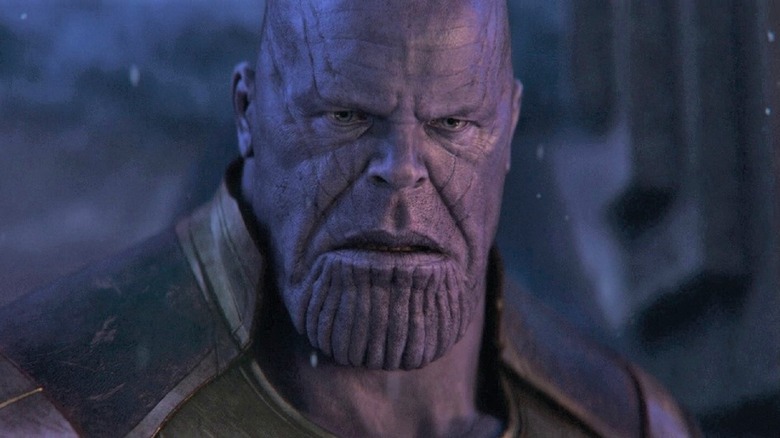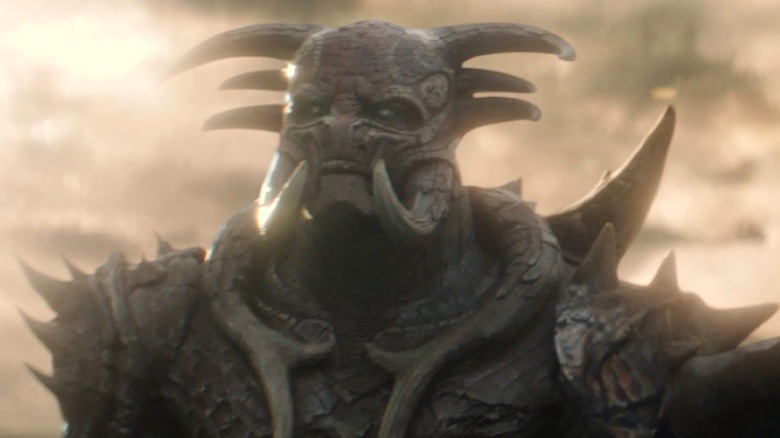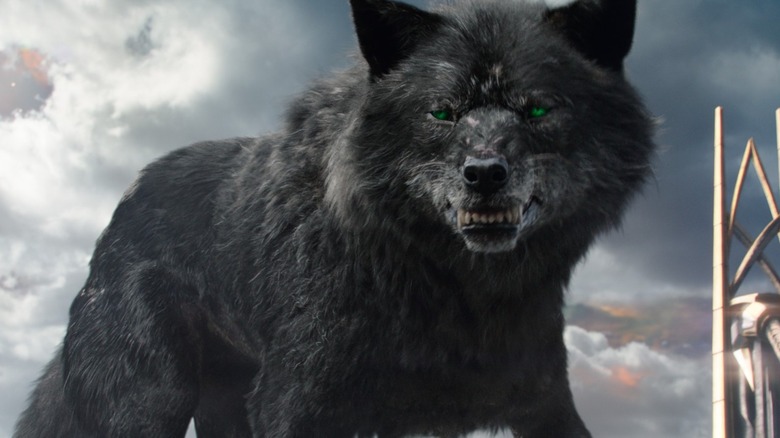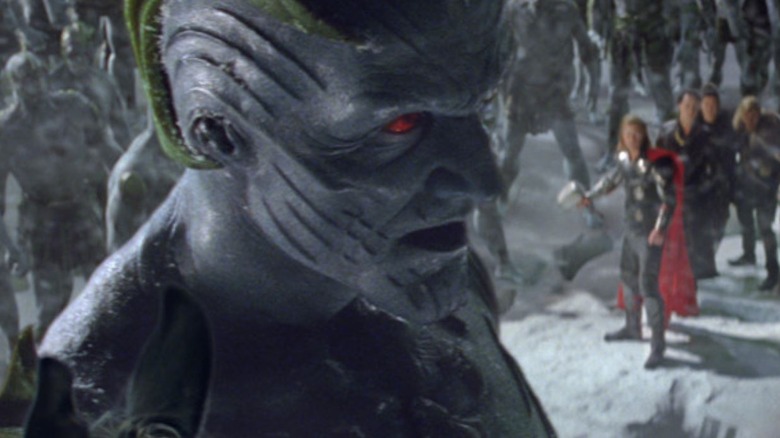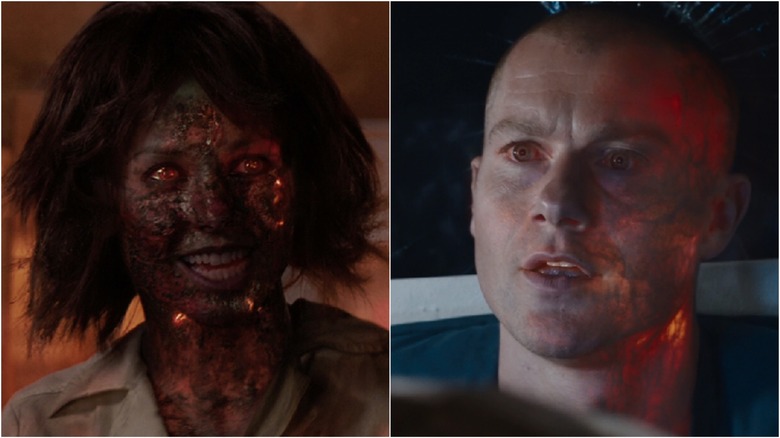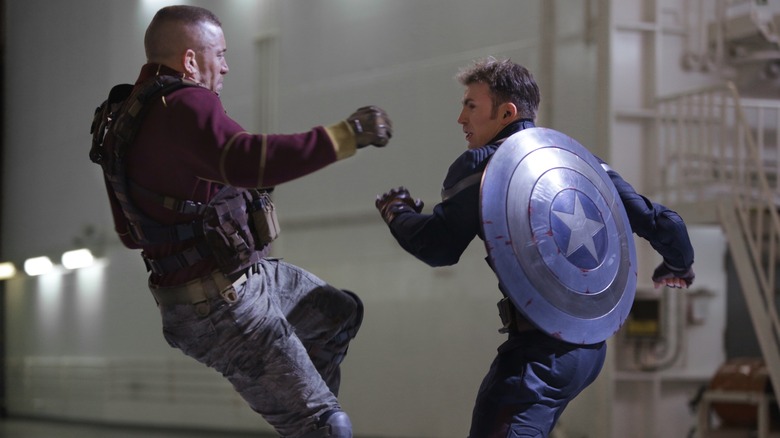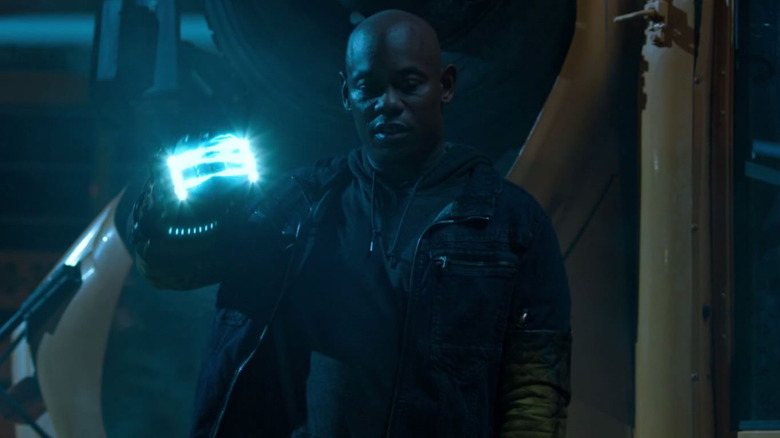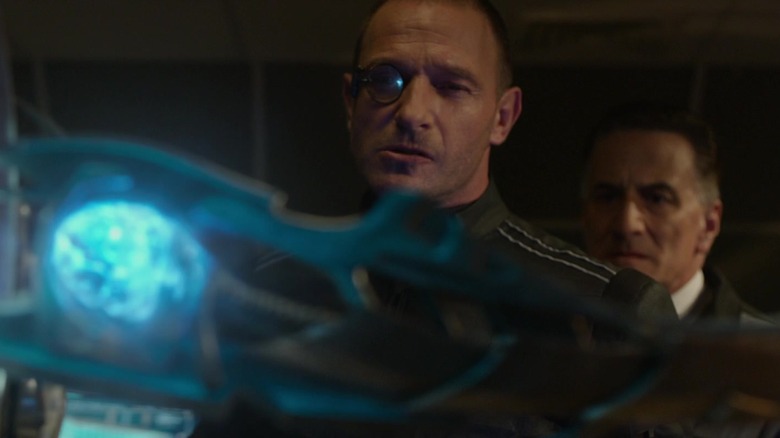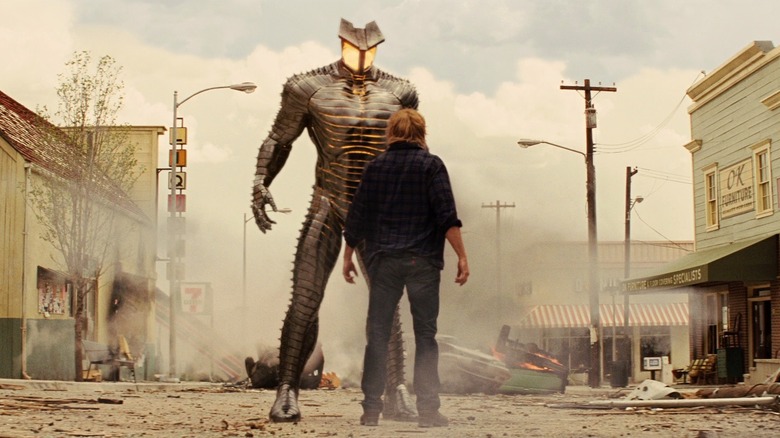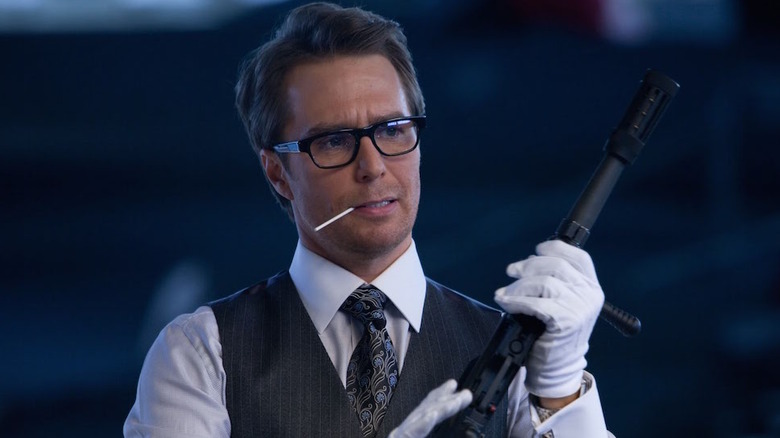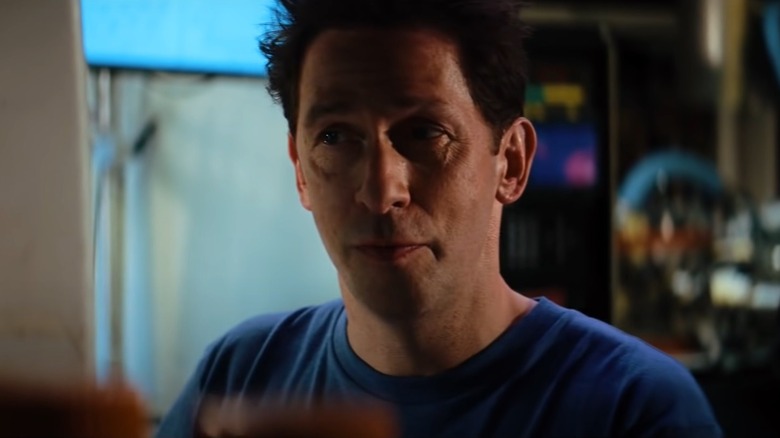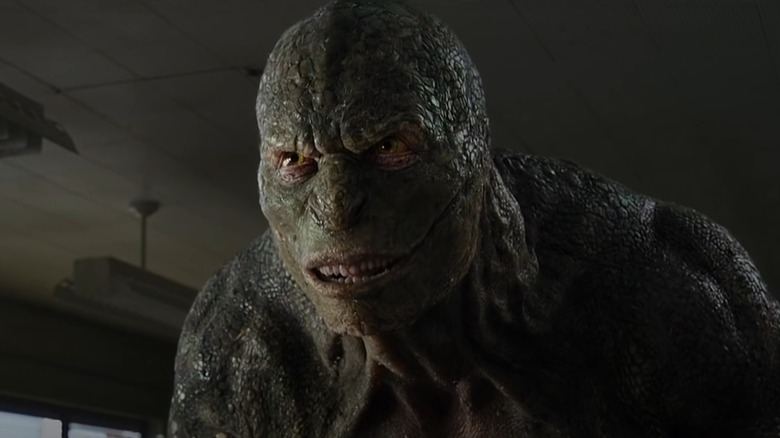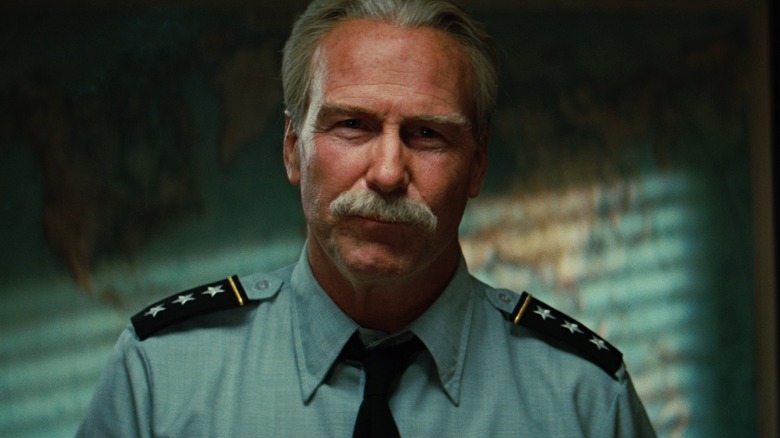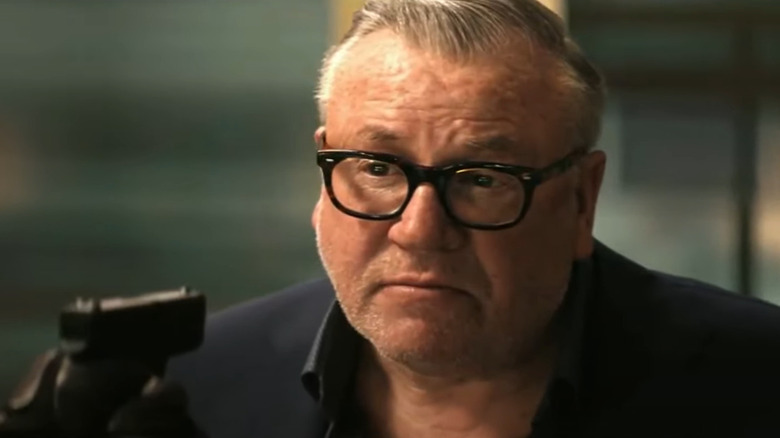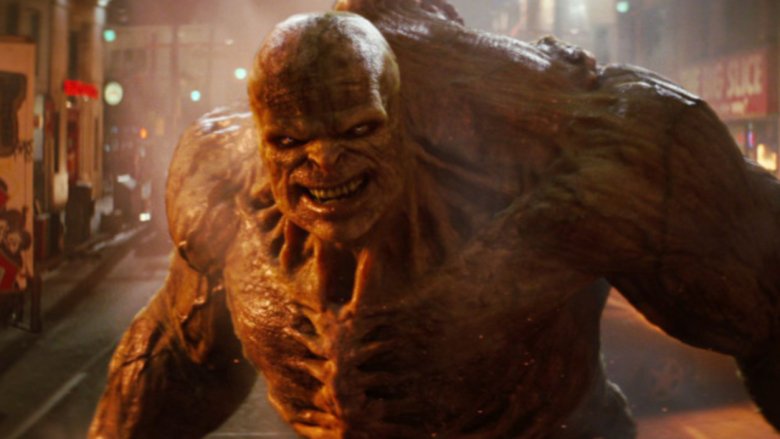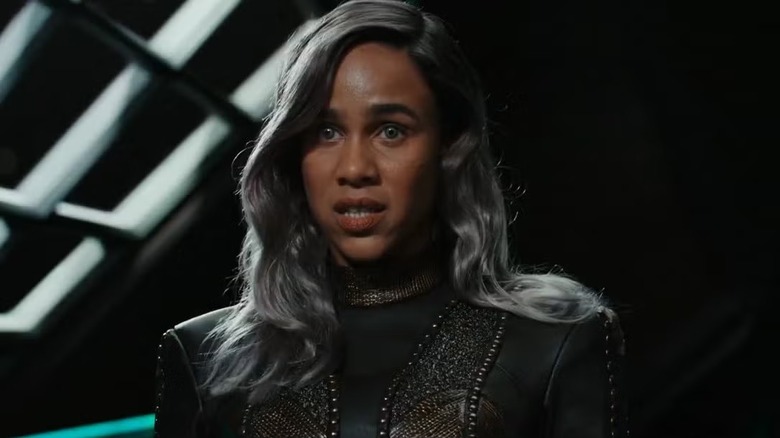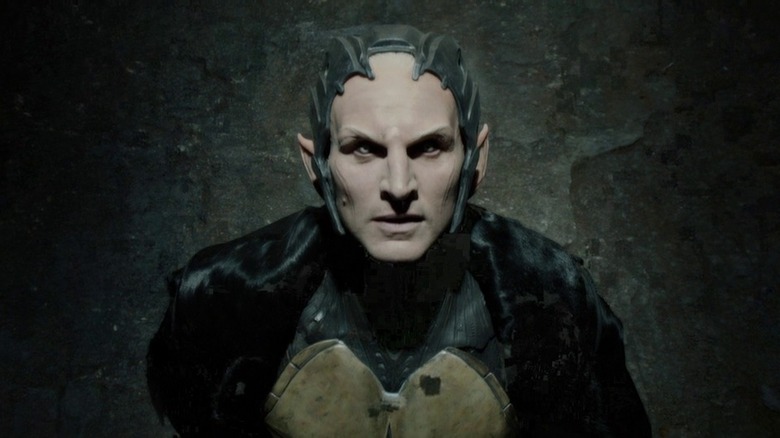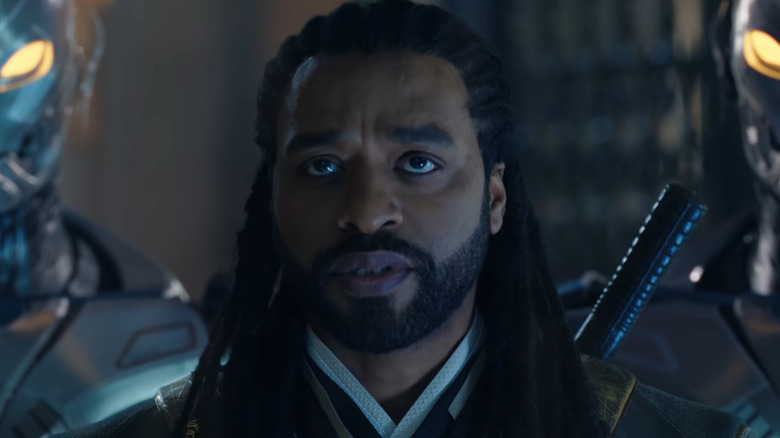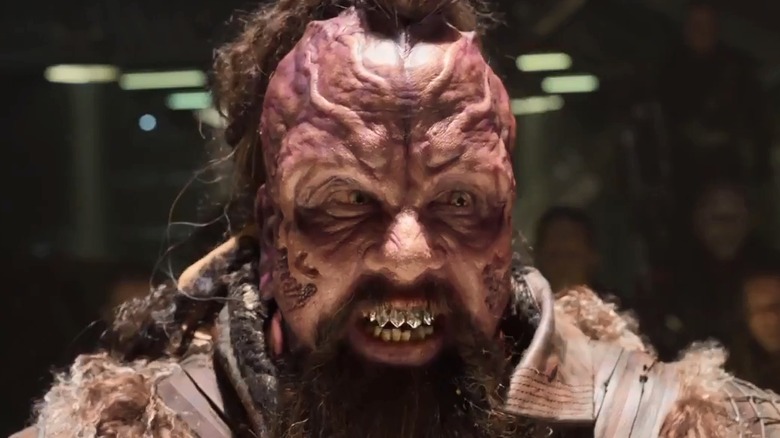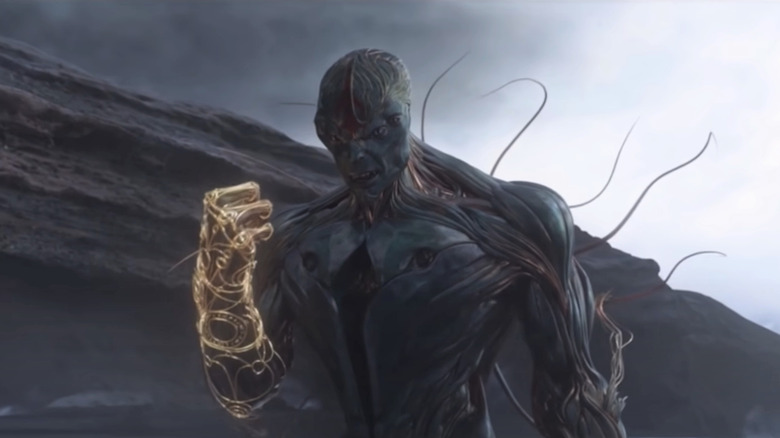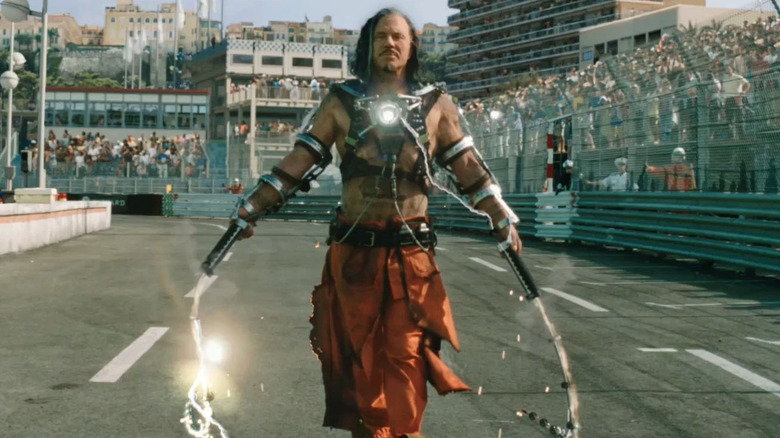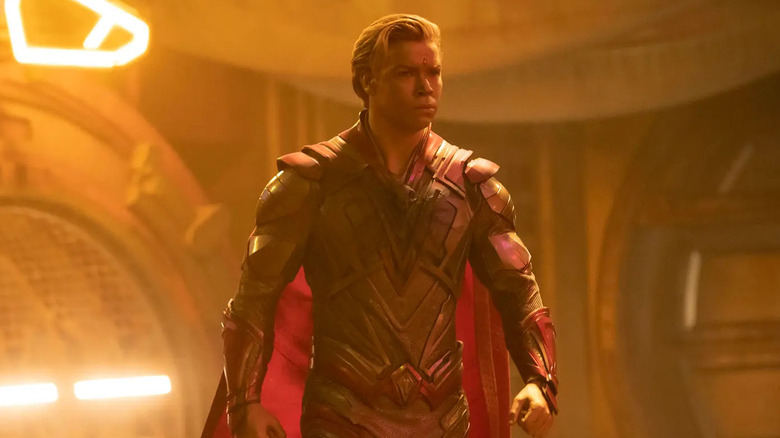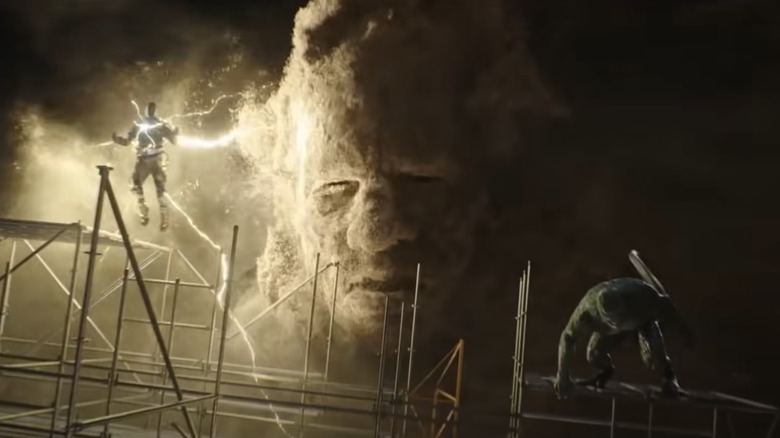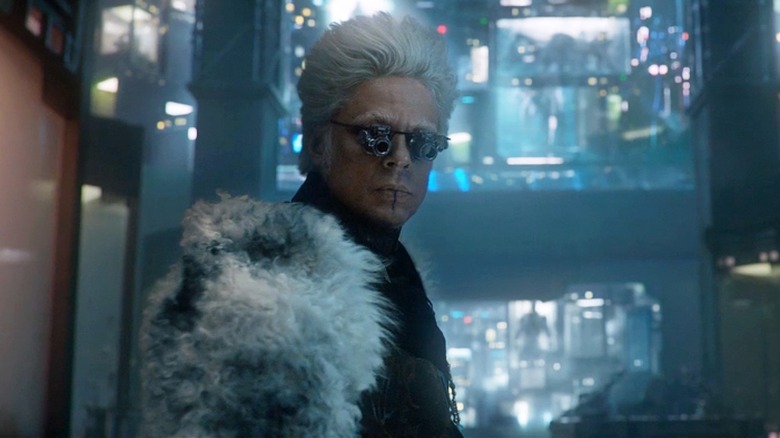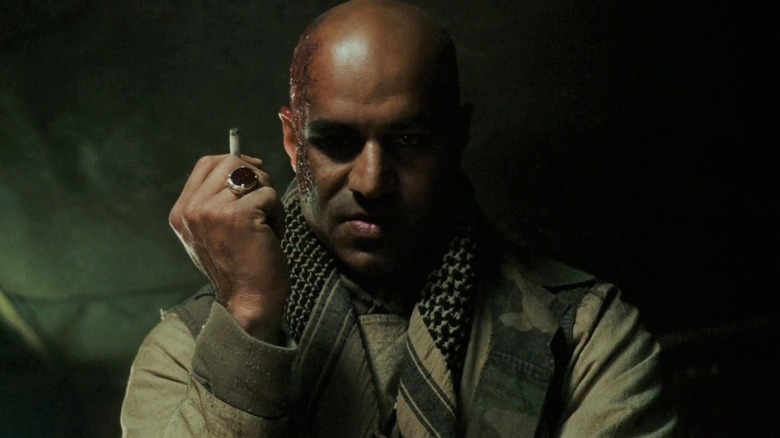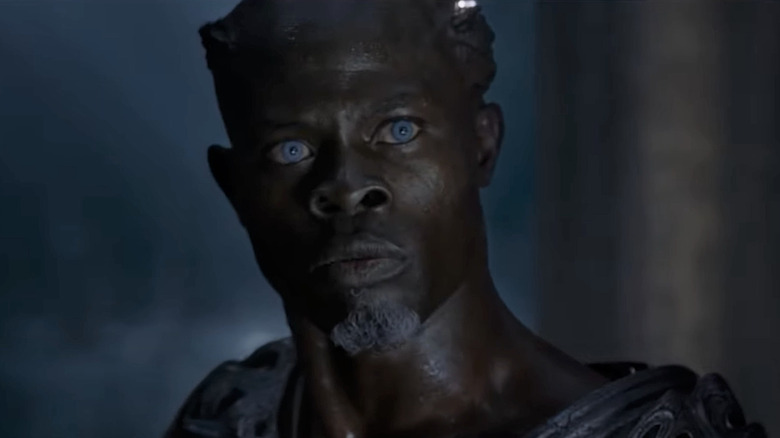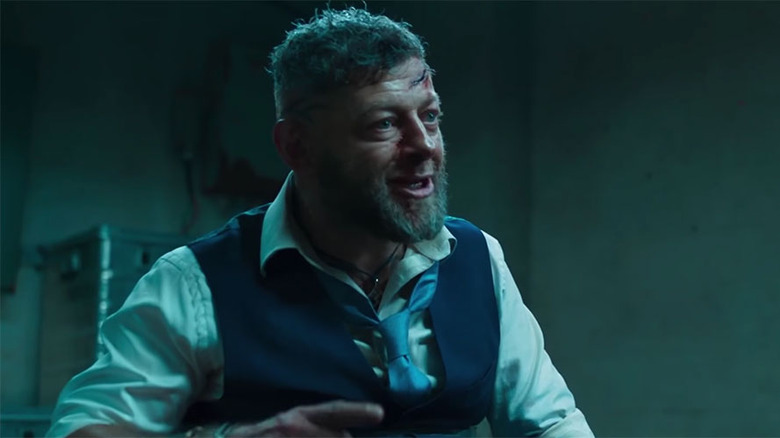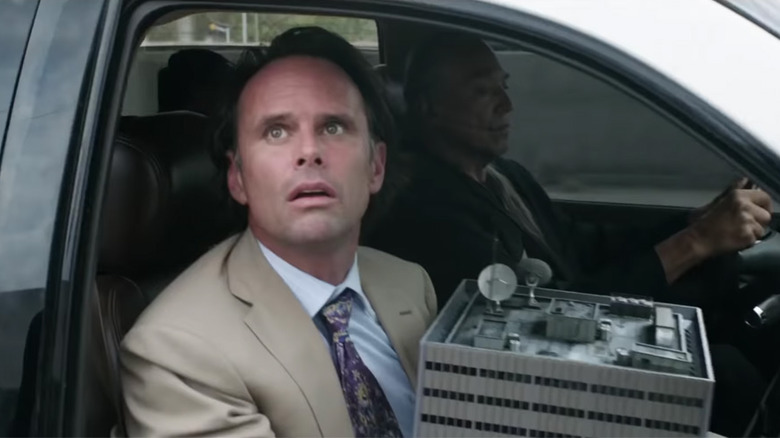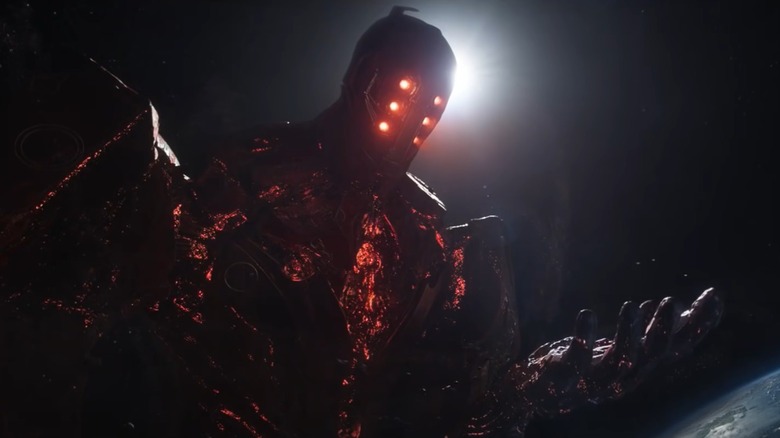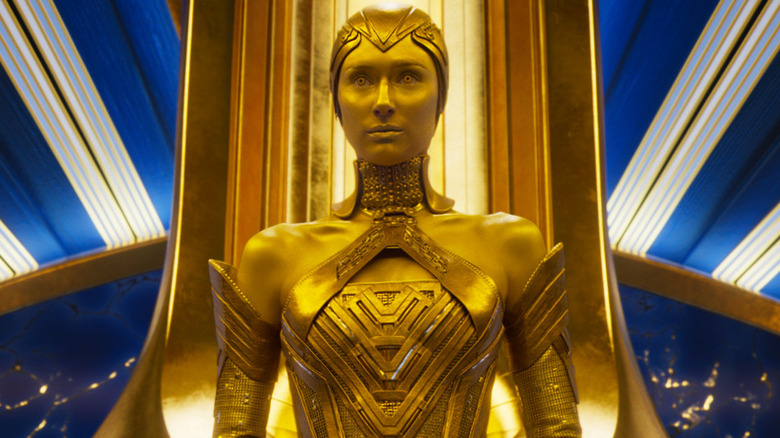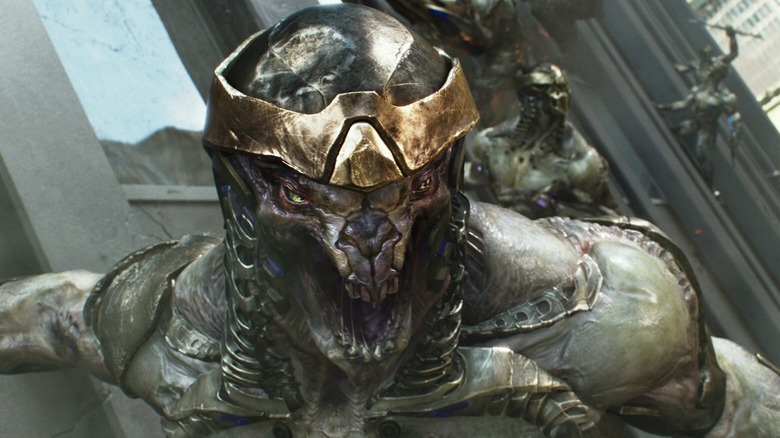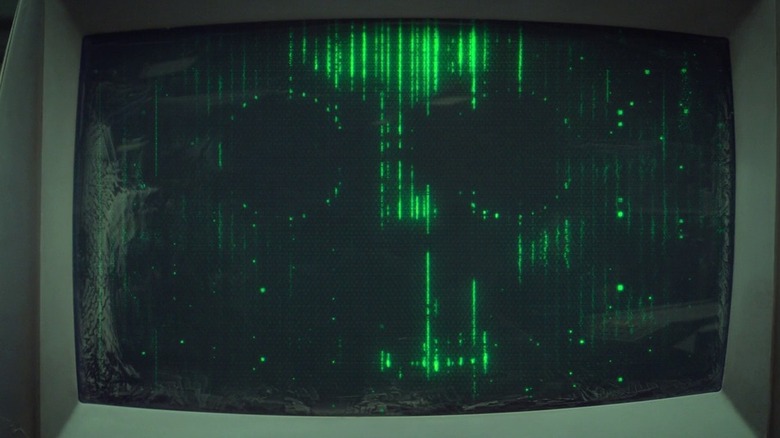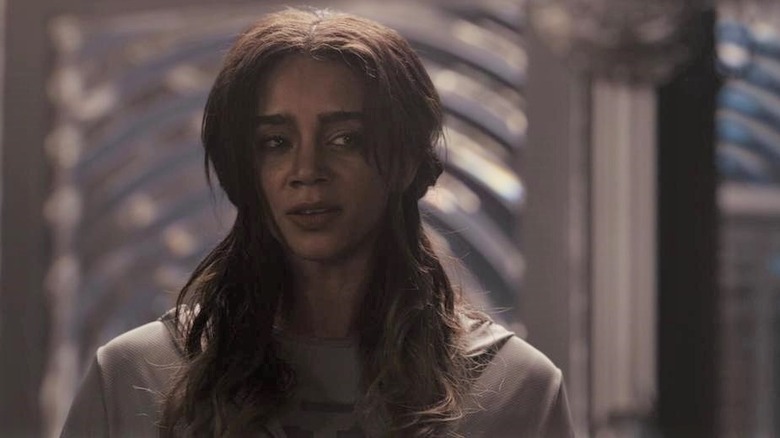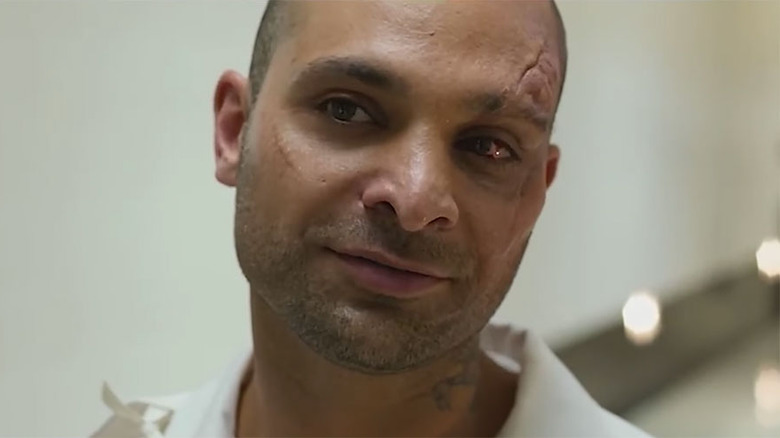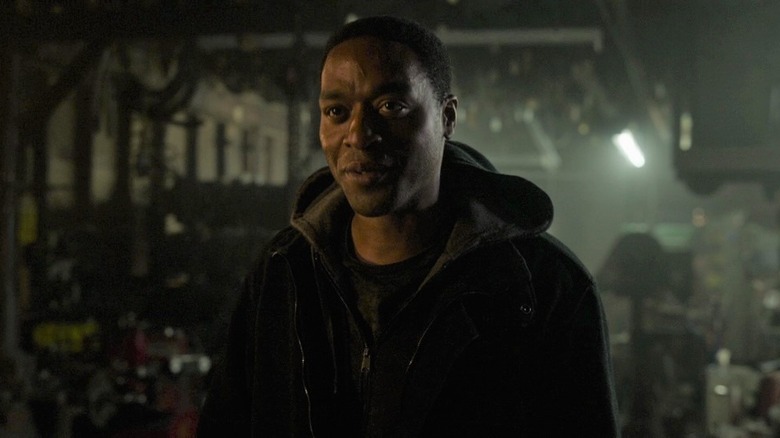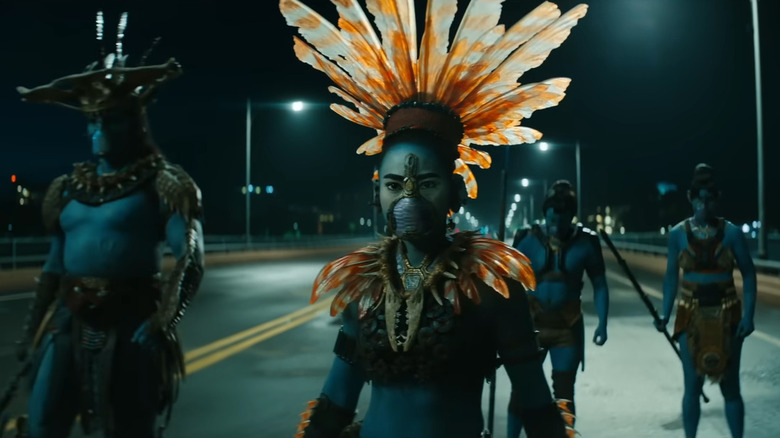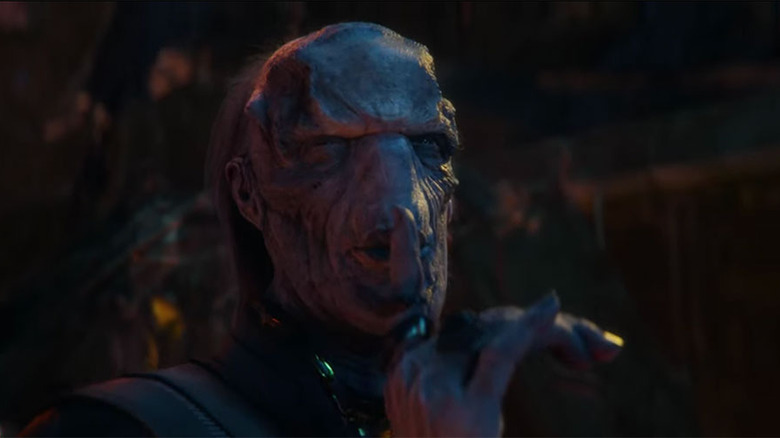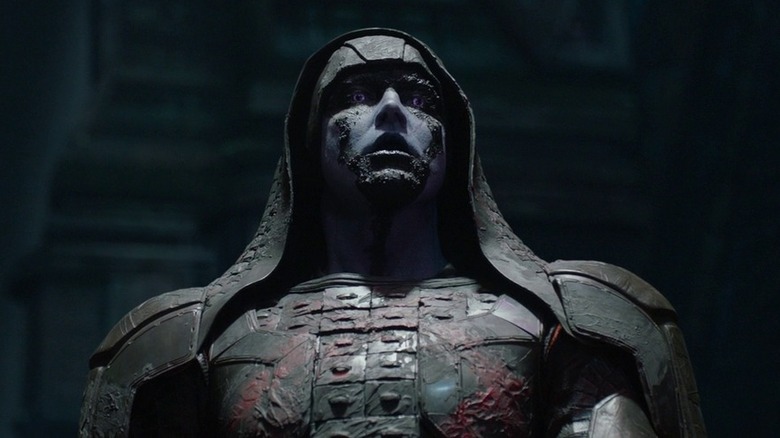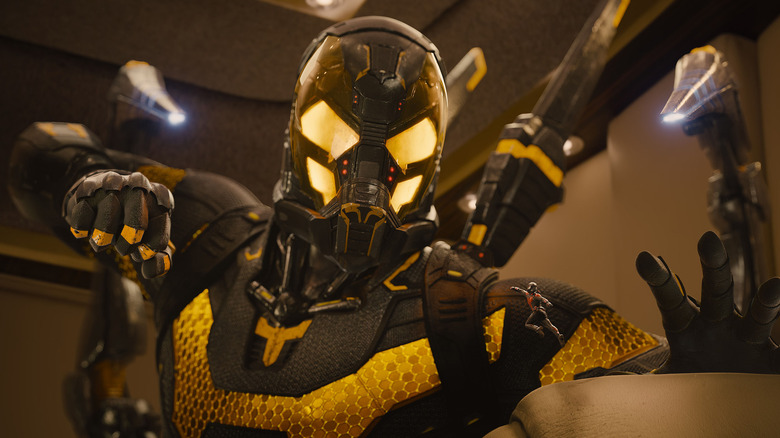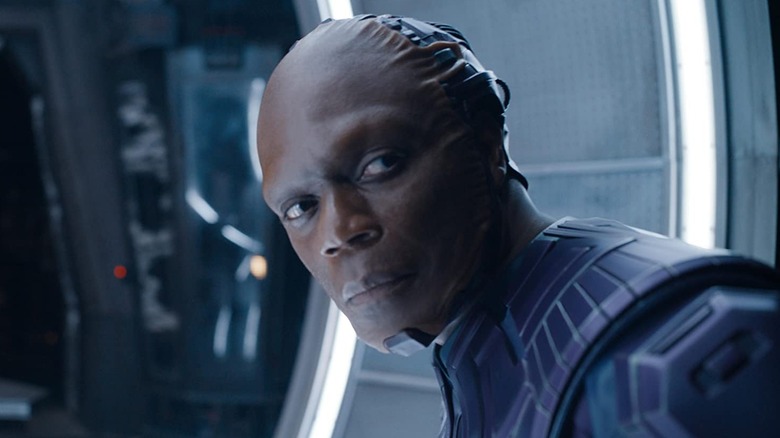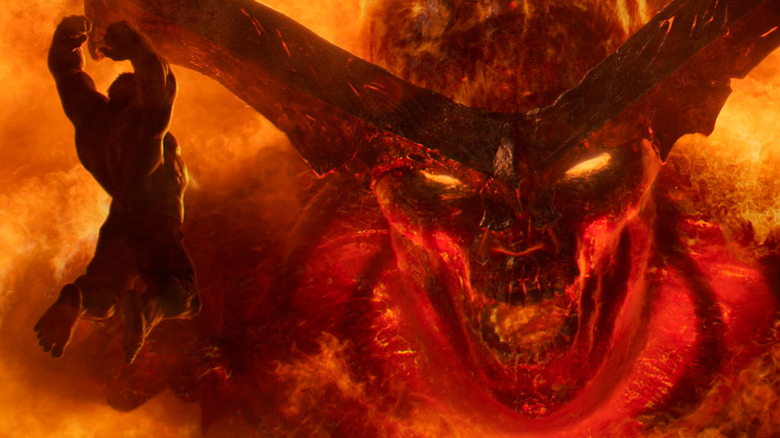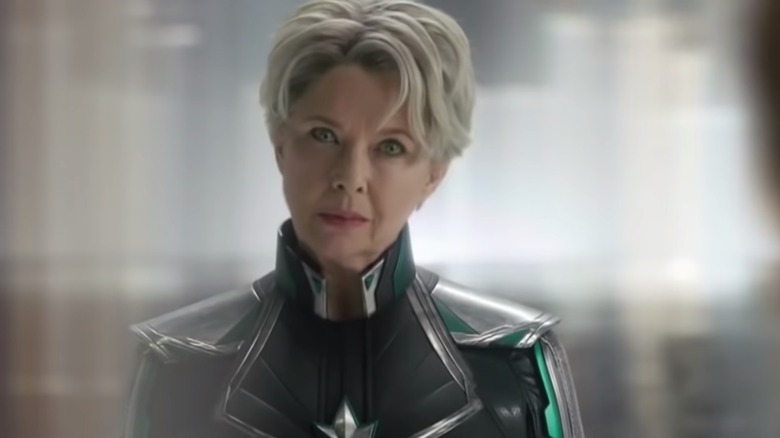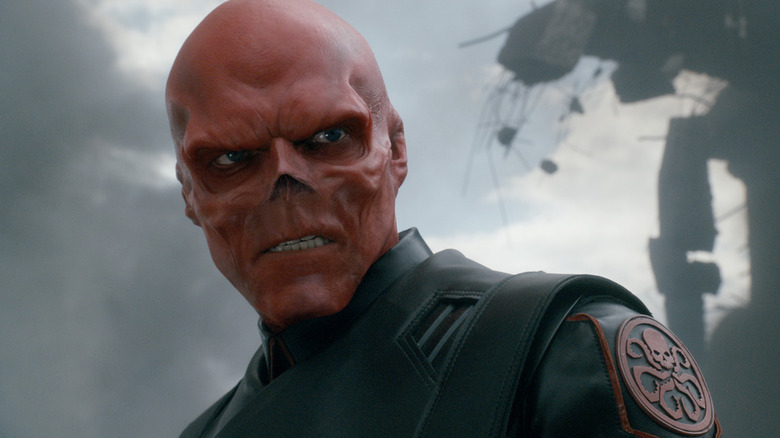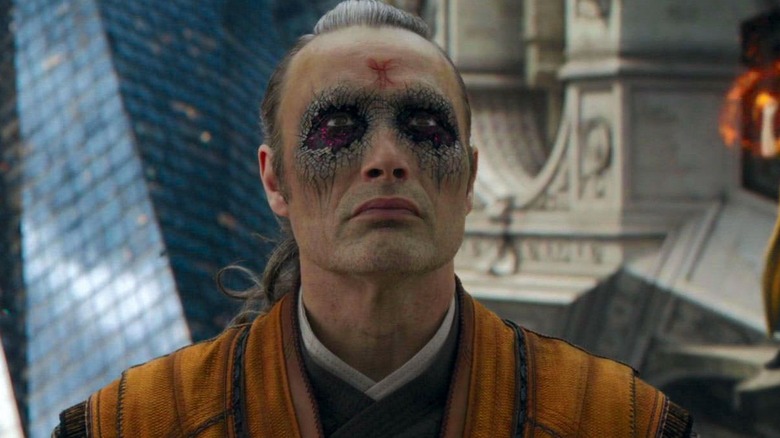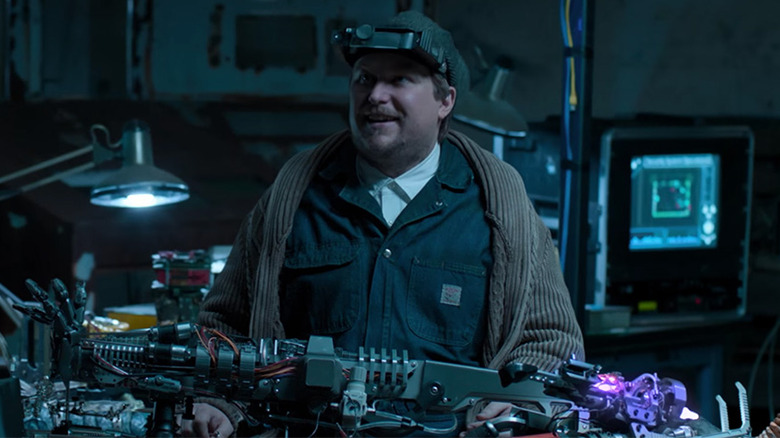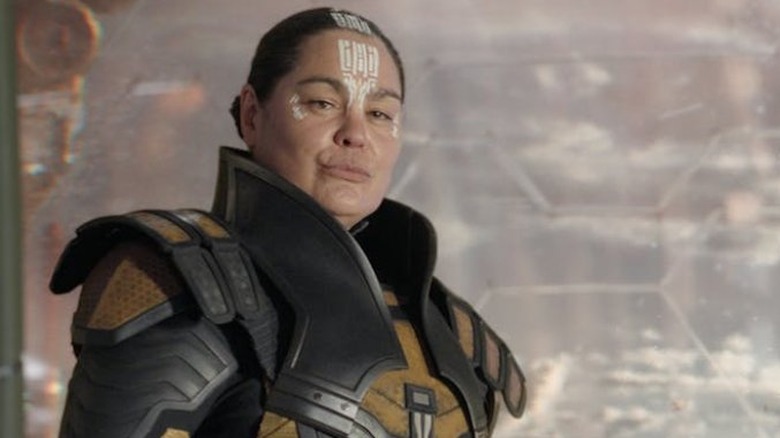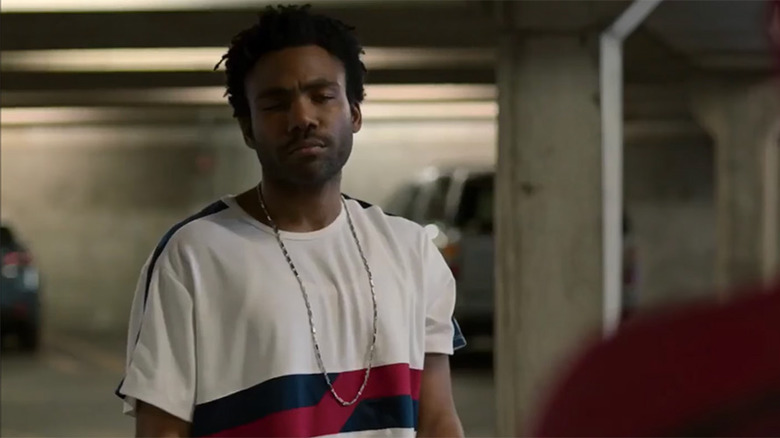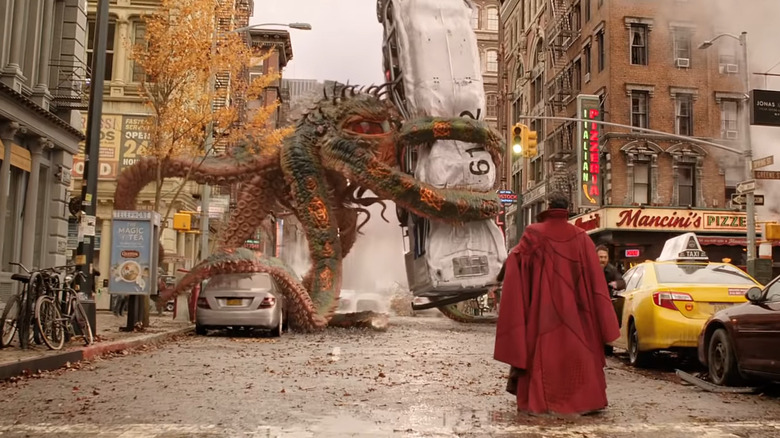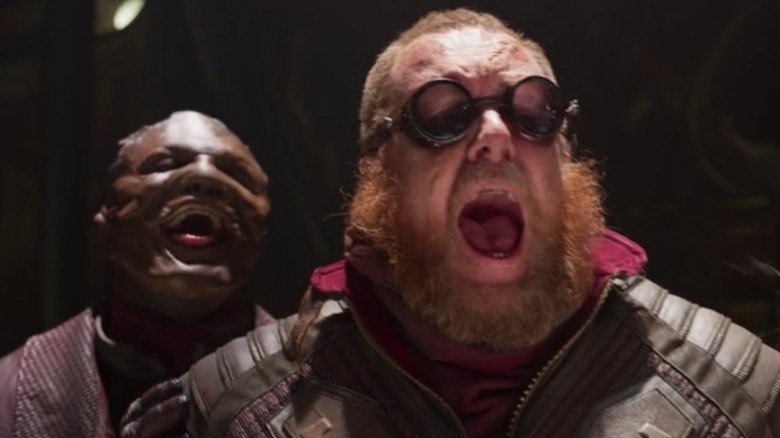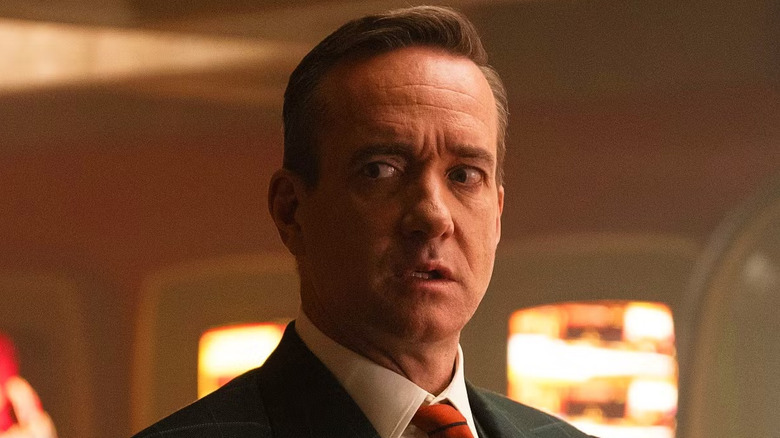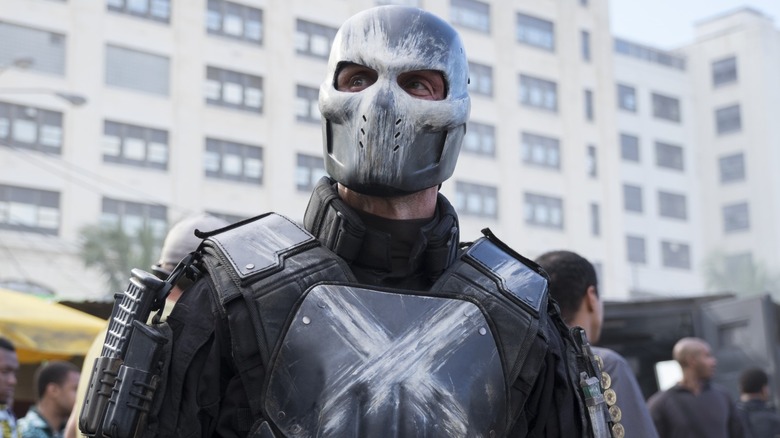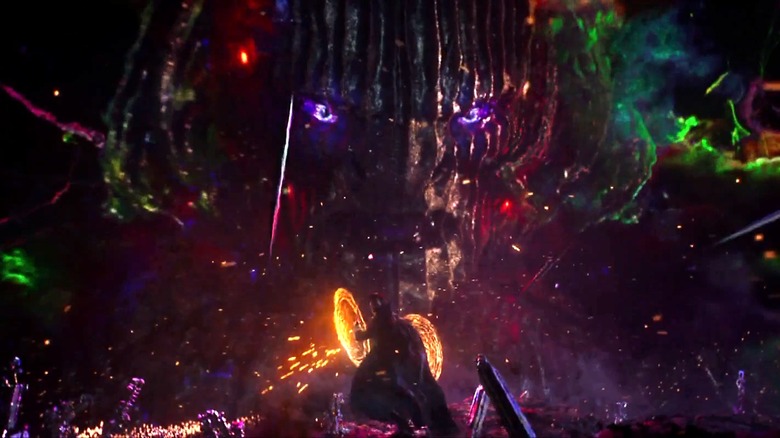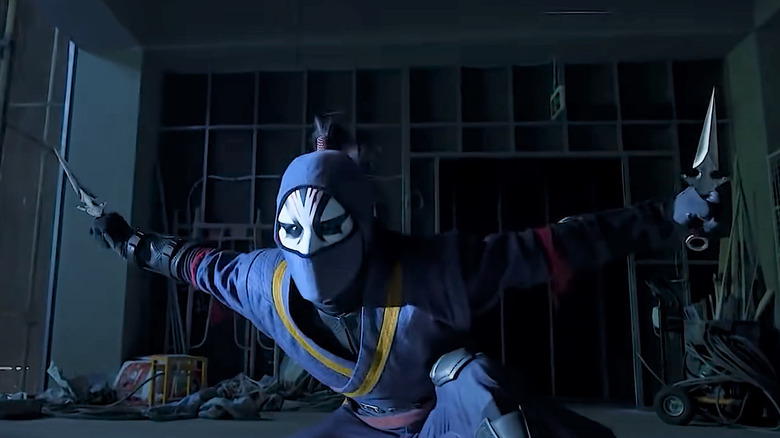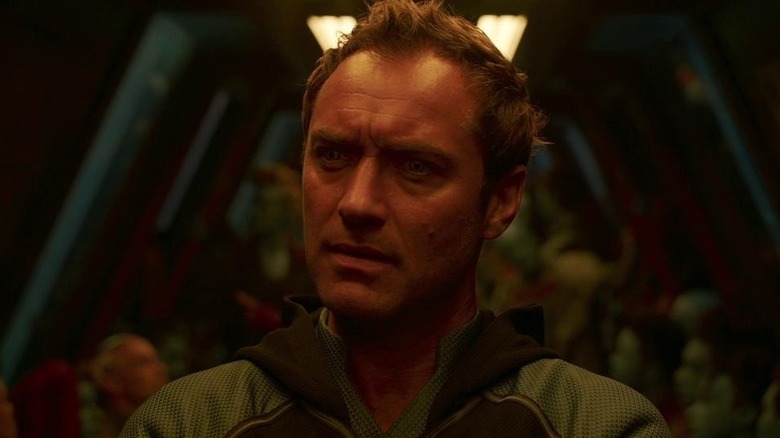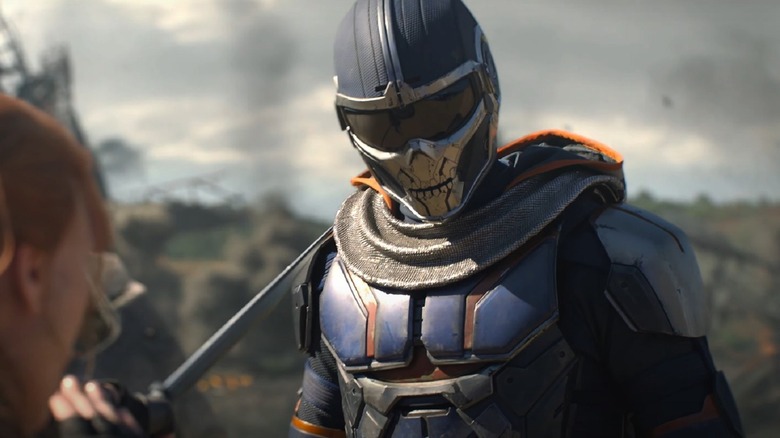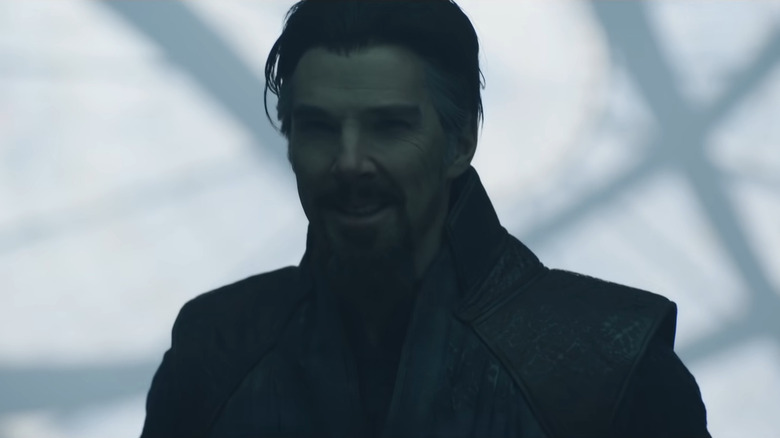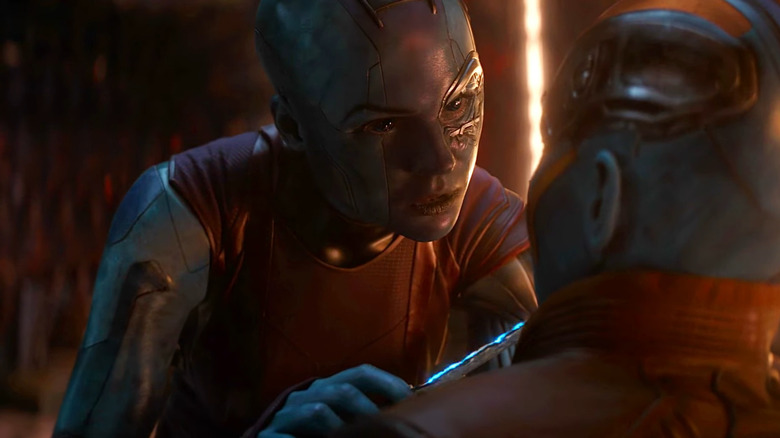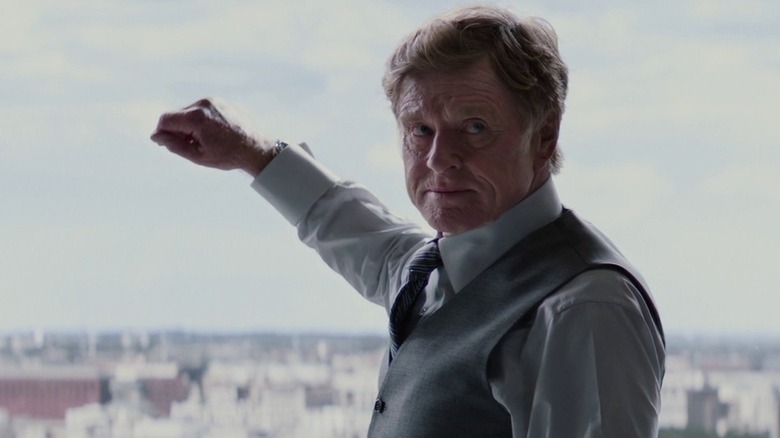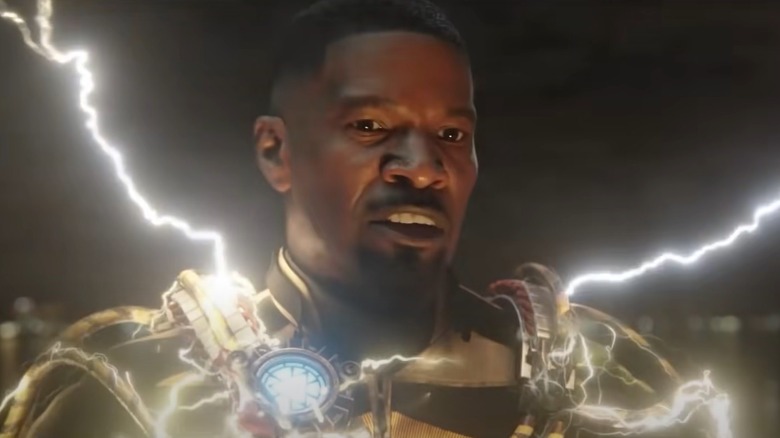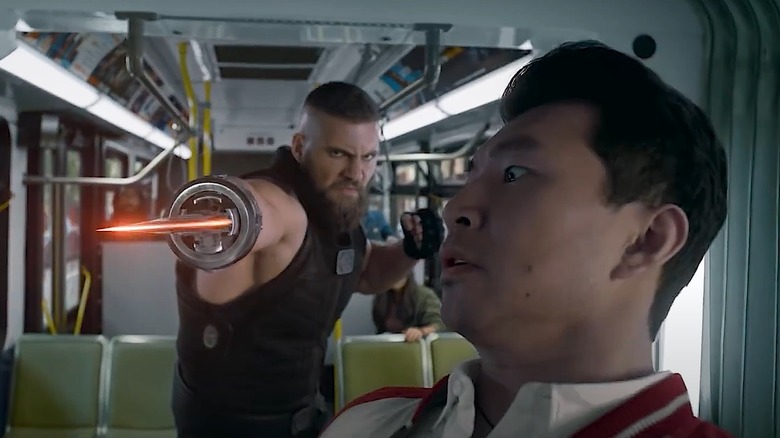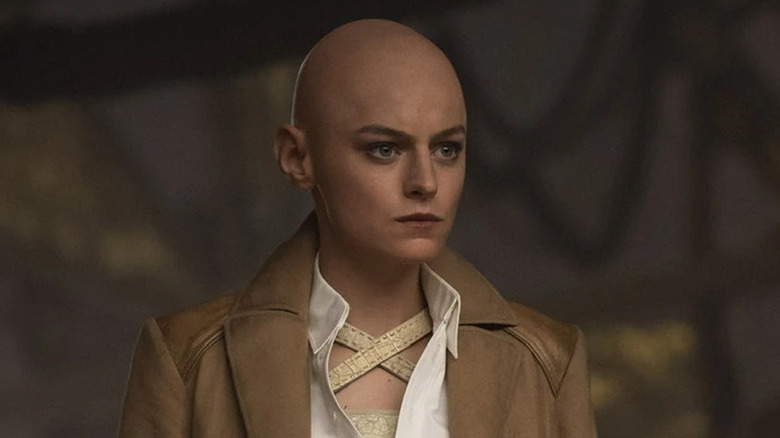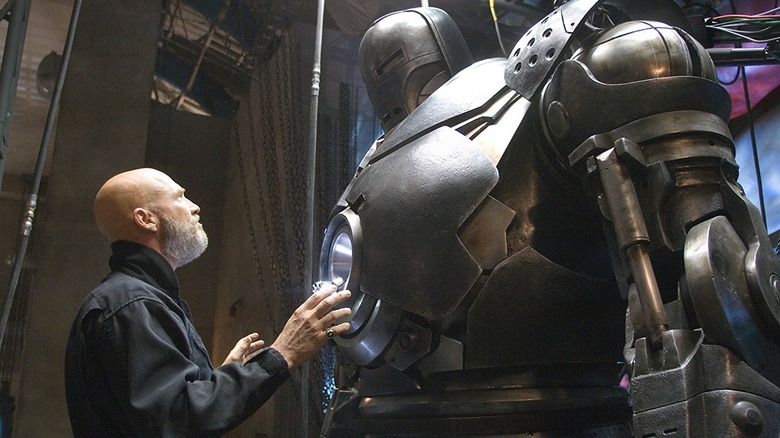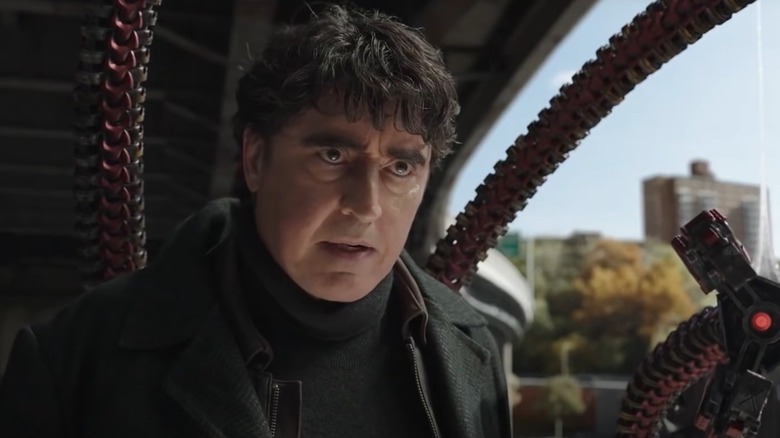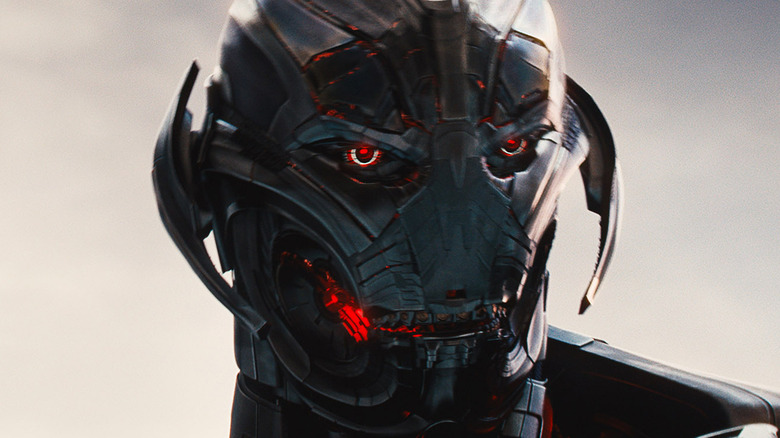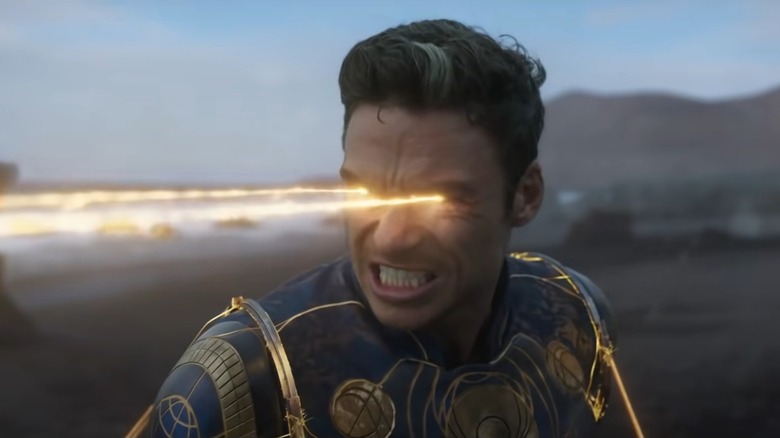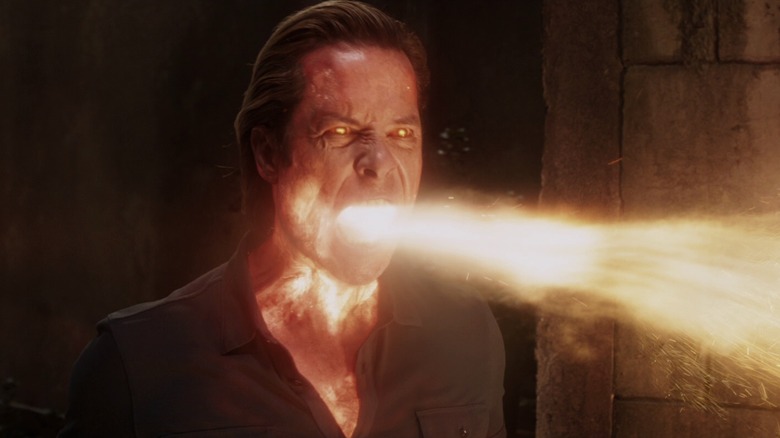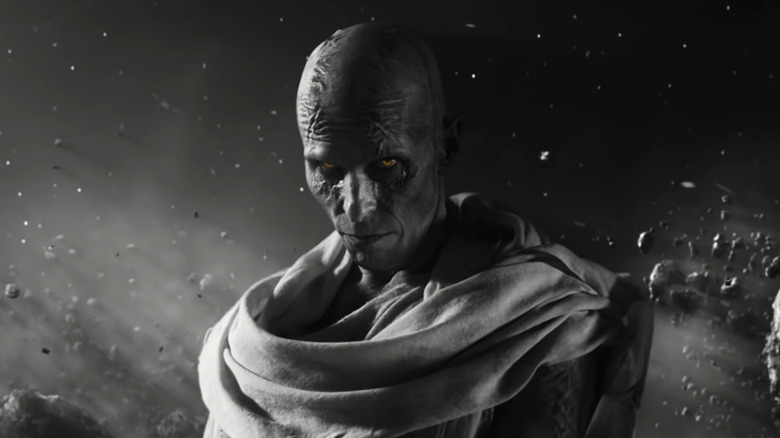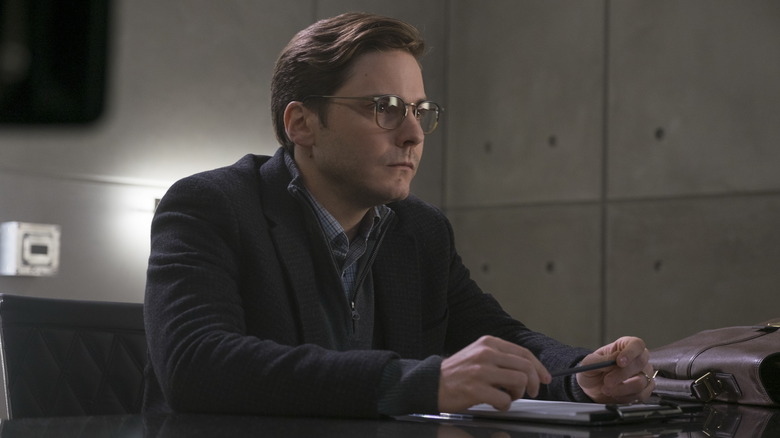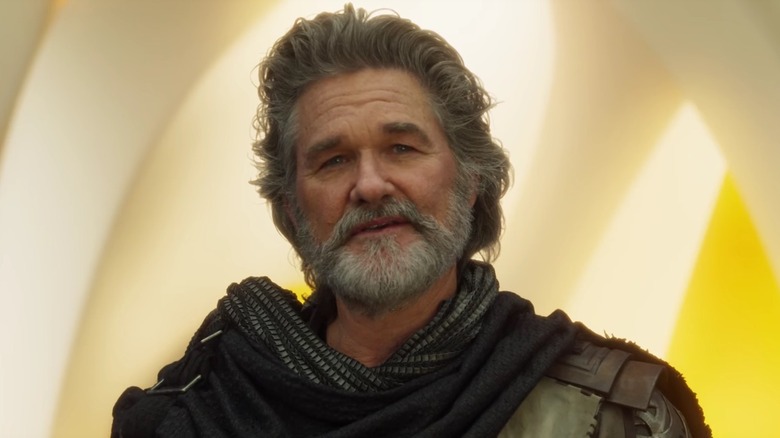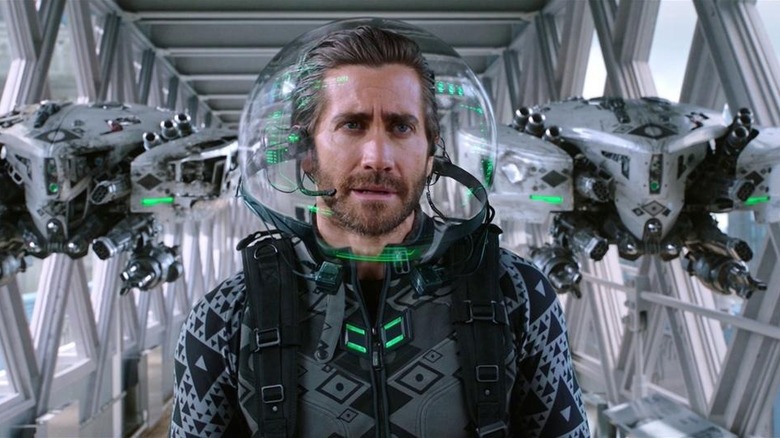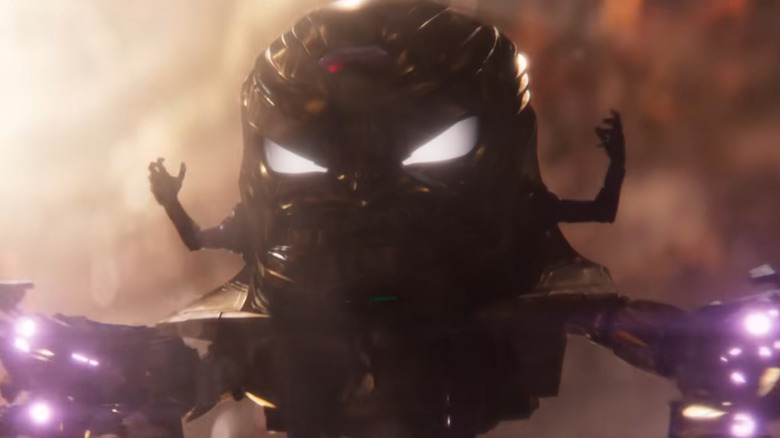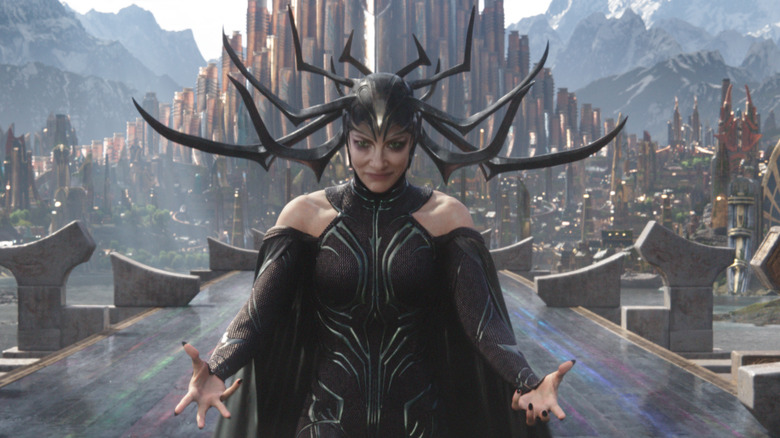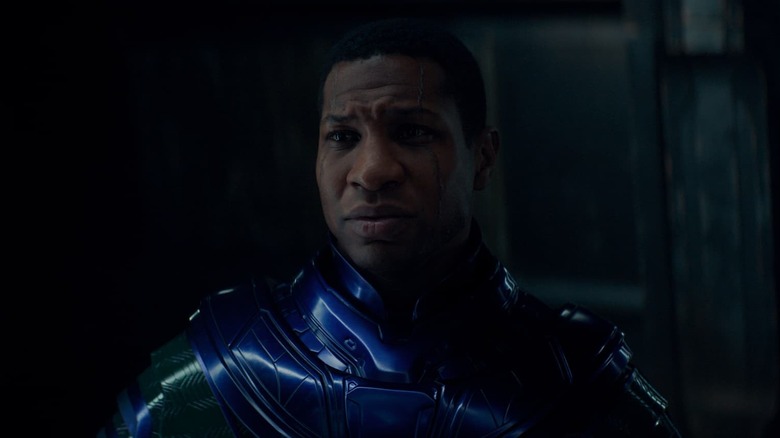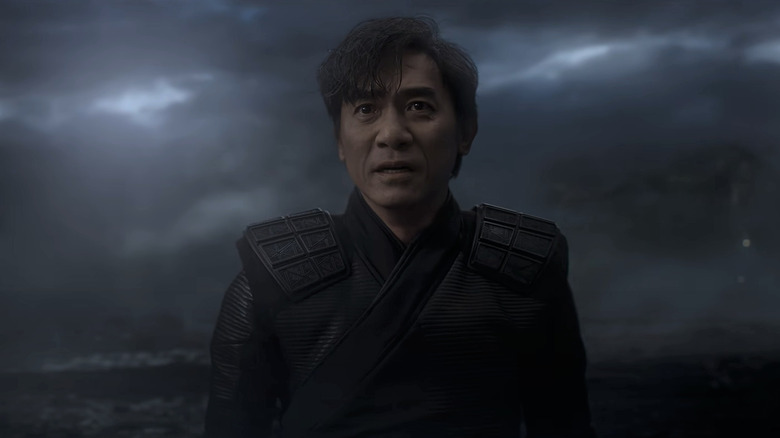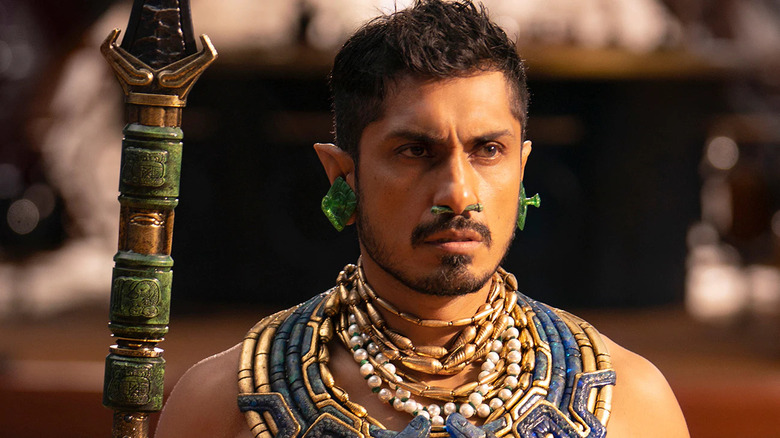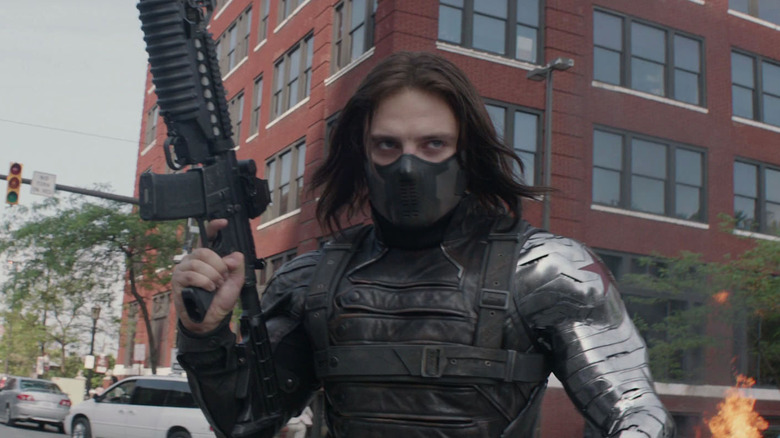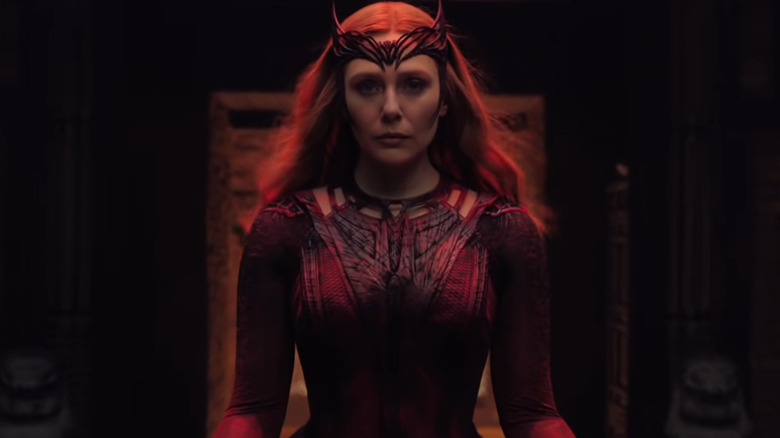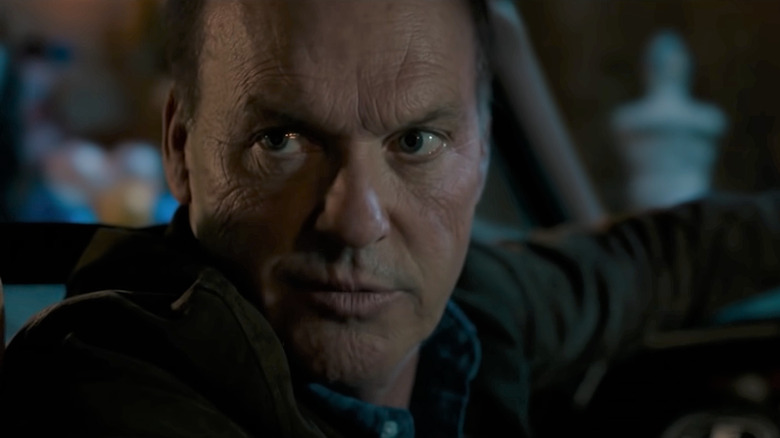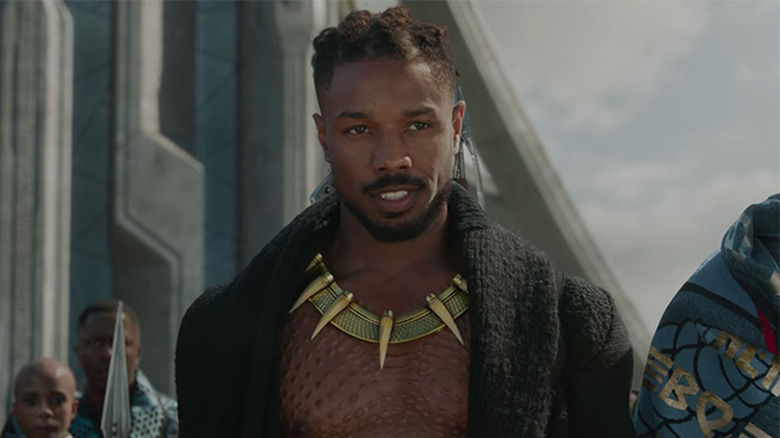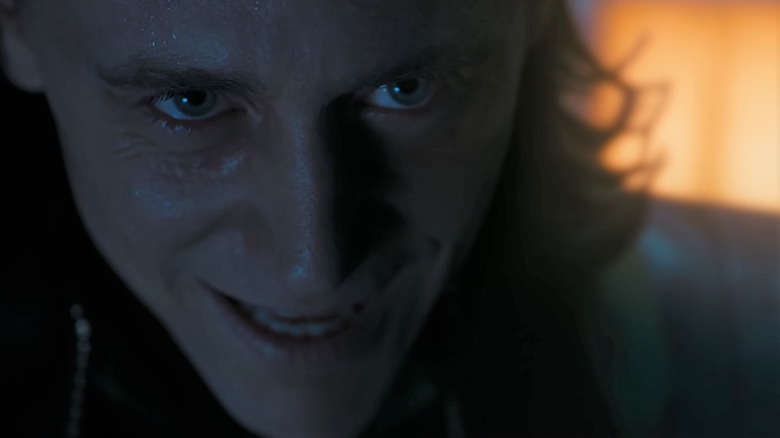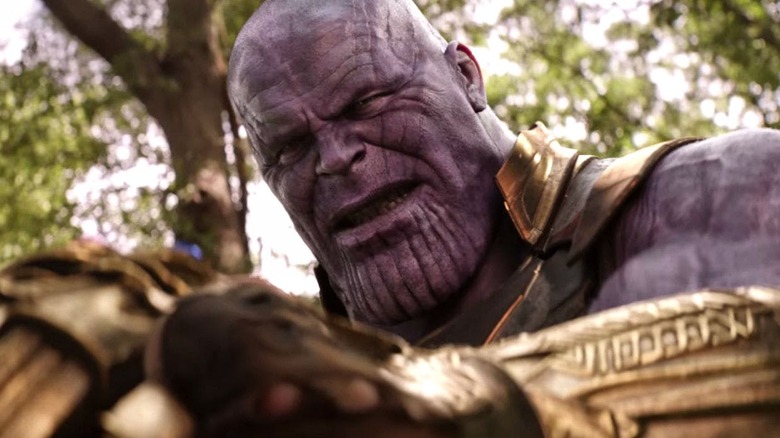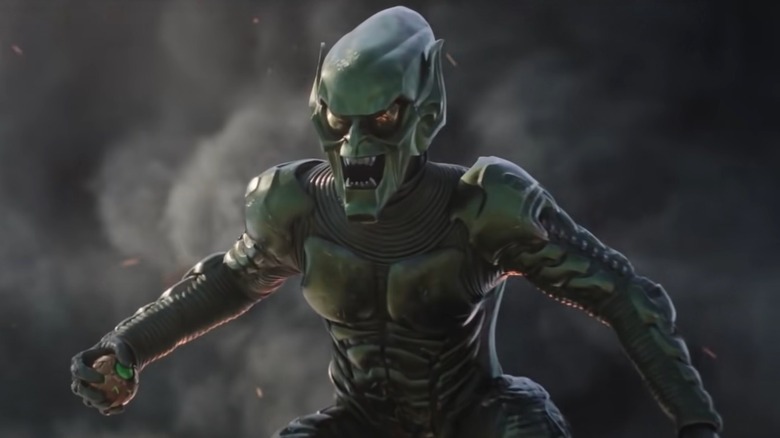Every MCU Movie Villain Ranked Worst To Best
Marvel has a lot of villains in its cinematic universe, but which ones stand above the rest when it comes to menacing Earth's Mightiest Heroes? To answer that increasingly complicated question, we've watched every MCU movie and ranked all the bad guys. And we do mean all of them: From "Iron Man" antagonist Obadiah Stane to Charles Xavier's evil twin Cassandra Nova from "Deadpool & Wolverine," we've covered the lot.
When it comes to the MCU, there's a widespread belief that the franchise has a "villain problem." Viewers have been keen to point out that many of the antagonists appearing in these movies are poorly written and far from compelling. However, while that's undoubtedly true in a number of cases, we've actually seen some pretty entertaining villains in MCU films over the years. Here's the franchise's entire villain roster ranked from worst to best.
83. Kurse (Thor: The Dark World)
Kurse (Adewale Akinnuoye-Agbaje), also known as Algrim, was one of Malekith's top men and sacrificed himself to take on the power of Kurse in "The Dark World." He allows Asgardian forces to capture him to get inside Odin's kingdom, and once he makes it to the Asgardian dungeon posing as a regular prisoner, Algrim activates the Kurse stone and turns into the hulking beast we know and love from the comics.
Kurse leads a straight-up prison riot in Asgard (with a bit of help from a locked-up Loki providing directions), helps Malekith sack Asgard, and actually kills Thor's mother, Frigga. He also leads the battle against Thor in the film's climax, beating the God of Thunder positively senseless with his brute strength before Loki manages to take Kurse out with some black hole grenades. Despite all that, Kurse is nothing more than a forgettable force of nature with no personality. He's just big and violent, and ultimately an obstacle cleared out of the way for the big finale between Thor and Malekith.
82. Fenris (Thor: Ragnarok)
Fenris, Hela's enormous wolf seen in "Thor: Ragnarok," is a very different beast in the comics. There, Fenris is actually a shapeshifting, genderfluid child of Loki, and is a much more formidable opponent than the undead beast of the MCU, who tries to finish off the Asgardian refugees toward the end of "Ragnarok."
To the wolf's credit — or more accurately, to the credit of the visual artists — Fenris looks cool. "Giant, menacing, green-eyed wolf" is a great concept, and the execution follows through. But sadly, Fenris really doesn't do much in the movie. After Hela animates her beloved familiar, Fenris just sort of hangs out and looks mean while the death goddess interrogates a crowd of scared Asgardians. In the final battle, Fenris tries and fails to kill the Hulk. On the one hand, it's nice to see another bad guy from Thor's mythos fit into the film. On the other hand, it seems like the only reason Fenris is included is because someone realized the Hulk needed something to tussle with during the climactic finale battle.
81. Laufey (Thor)
Laufey (who looks nothing like actor Colm Feore in real life) is a powerful force in Thor's corner of the Marvel Cinematic Universe, but we never get to see a lot of him in action. King of the Frost Giants and biological father to Loki, he has super-strength and ice powers, but it turns out he's still no match for the sneakiness of his own son. Loki manipulates events to get Laufey to attack Asgard in "Thor," but just as Laufey is about to kill Odin, Loki takes out Laufey instead — simultaneously killing the Frost Giant king and making himself look like a hero. Certainly an unceremonious end.
80. Brandt and Savin (Iron Man 3)
Aldrich Killian turned out to be the A-list bad guy in "Iron Man 3," with Brandt (Stephanie Szostak) and Savin (James Badge Dale) shaping up as little more than B-list versions with the same power set. Both Brandt and Savin are given their super-heating and healing powers by the Extremis virus, and they both attack Tony Stark throughout the film, but neither is a match for Iron Man, even when he doesn't have his suit. Brandt is best known for jumping Stark in a dive bar, where he outmaneuvered her and managed to blow her up with a gas leak. Savin hung around a little longer, even stealing the Iron Patriot armor at one point, but he was still outsmarted by Iron Man and defeated with an energy blast.
79. Batroc the Leaper (Captain America: The Winter Soldier)
It's easy to forget, but yes, Batroc the Leaper is part of the Marvel Cinematic Universe. We meet the French mercenary during the action sequence that opens "Captain America: The Winter Soldier," during the hijacking of the ship the Lemurian Star. We get a breathless fight scene between Batroc and Cap, with the First Avenger accepting the challenge for a hand to hand fight without his shield. Batroc manages to hold his own — he's a beast when it comes to parkour — though Cap eventually knocks him out. And while actor/UFC champion Georges St-Pierre reprised the character in the Disney+ series "The Falcon and the Winter Soldier," it did little to raise his stock among the MCU's biggest and best villains.
78. Dweller-in-Darkness (Shang-Chi and the Legend of the Ten Rings)
The real villain of "Shang-Chi and the Legend of the Ten Rings" is not the titular hero's father, Xu Wenwu (more on him shortly), but the being that tricked him into waging war on the hidden, magical realm of Ta-Lo. Known as the Dweller-in-Darkness, this butt-ugly beast is the leader of the Soul Eaters, a race of winged creatures that feed on (you guessed it) human souls. Thousands of years before Shang-Chi walked the earth, the Great Protector imprisoned the Dweller-in-Darkness inside a mountain, though it never stopped trying to escape. When it does break free, Shang-Chi has to take the ten rings (ancient objects that grant the wearer a variety of powers) and bring the beast down before it wreaks havoc on Ta-Lo once more.
Watching Shang-Chi ride the Great Protector (think Falkor from "The NeverEnding Story" meets Haku from "Spirited Away") as he does battle with the Dweller is undeniably cool, but as a villain, the big bad Soul Eater is actually pretty dull. While it's definitely one of Marvel's scarier CGI designs, the character is totally forgettable, a mass of tendrils and teeth that's hard to make out in the dimly lit final showdown. By the time Shang-Chi blows the beast to bits, we're already missing his recently departed dad — the Dweller-in-Darkness ate Wenwu's soul after he released it, though not before he could pass the rings on to his son.
77. The Shocker(s) (Spider-Man: Homecoming)
"Spider-Man: Homecoming" didn't just give us our first solo Spidey flick in the Marvel Cinematic Universe, it also dug into the wall-crawler's deep bench of rogues, including not just one but two Shockers. We first meet Jackson Brice (Logan Marshall-Green) wielding a Shocker gauntlet, but after the Vulture kills him, the trademark weapon is passed down to Herman Schultz (Bokeem Woodbine).
Schultz looks to be our "main" Shocker in the MCU, and he gets one epic fight against Spidey before being sidelined. The Shocker jumps Peter as he leaves the school dance attempting to follow the Vulture, and sends him flying through a school bus (and he loses his web-shooters, to boot). So why does Shocker rank so low? Because it wasn't even Spidey who took him out — it was Pete's pal, Ned, who grabs the web-shooter and hits Shocker, distracting him long enough for Spidey to web him to a school bus, gift-wrapping him for the cops. Maybe next time, Shocker. Maybe next time.
76. Baron Strucker (Avengers: Age Of Ultron)
Baron Wolfgang von Strucker's lasting legacy in the Marvel Cinematic Universe is leading the experiments on Loki's scepter that created Quicksilver and the Scarlet Witch, so he's definitely an important player, but all anyone really remembers is his immediate surrender to the Avengers during the opening of "Age of Ultron." It's a funny gag, as Strucker (Thomas Kretschmann) gives a pep talk to his Hydra soldiers urging them to never give up — then he immediately surrenders, though he admittedly does so in a failed a attempt to hide his research. He also gets a few callouts on the companion series "Agents of S.H.I.E.L.D." during that show's Hydra arc but nothing much of substance. In the end, Strucker was just another upper-level Hydra goon. Cut off his head, and nobody really noticed.
75. The Destroyer (Thor)
It doesn't get a ton of screen time in "Thor," but when the Destroyer shows up, it sure makes full use of every moment. Basically an enchanted Asgardian automaton you can point at an enemy, its giant, powerful arms and legs can crush or stomp just about any opponent — and if they don't kill you, its laser blasts probably will. In "Thor," we saw the Destroyer kill a few Frost Giants, then lay waste to a small town in New Mexico when Loki sent it to Earth hunting Thor. Still, it was finally no match for Thor: the God of Thunder regained his power and overcharged the Destroyer, ending the attack.
74. Justin Hammer (Iron Man 2)
Credit Sam Rockwell's unending charisma for Justin Hammer not showing up at the very bottom of this list — or even further down, if we could find a way to put him there. As far as credible villains are concerned, Justin Hammer is an absolute joke. He runs an arms manufacturer that's a rival to Stark Industries, except literally everything Hammer builds falls apart. The first version of the War Machine armor is basically a bare-bones Iron Man suit outfitted with a ton of Hammer weapons, which works about as well as gluing and duct taping accessories to a car.
In "Iron Man 2," Hammer cuts a deal with Ivan Vanko that lands him in jail, and that's pretty much the last we see of him until the Marvel One-Shot "All Hail the King," in which Hammer gets a brief cameo in prison, showing some resentment for the fame Trevor Slattery (aka the fake Mandarin from "Iron Man 3") has garnered at Seagate Prison.
73. The Leader (The Incredible Hulk)
Dr. Samuel Sterns doesn't actually ever call himself the Leader, which is his villainous moniker in the comics. But "The Incredible Hulk" isn't exactly subtle about the eccentric scientist's destiny. The last we see of him, he's on the ground as the Hulk-ified blood he just pumped into Emil Blonsky drips into an open wound on his head. If a "Hulk" sequel had come to pass, we would almost certainly have seen Tim Blake Nelson return as the psychic and super-intelligent Leader.
Nelson is perfect as an obsessed scientist who doesn't care much about the consequences of pursuing his goals across ethical lines. While he never actually turns green on screen, he shows plenty of signs of a moral compass in need of some fine tuning. He clones a whole room full of Banner's blood without Bruce's knowledge or consent, and he has no problem with the notion of turning Blonsky into Abomination. And of course, in his final moments in the movie — while Banner's blood begins to change him and Abomination starts his deadly rampage — he is seen smiling, when any sane person would be horrified.
We should note that even without an "Incredible Hulk" sequel, Kevin Feige has made it clear that "never say never" is the correct attitude to take, when it comes to Nelson possibly returning as the Leader. Fingers crossed!
72. Lizard (Spider-Man: No Way Home)
"Spider-Man: No Way Home" masterfully blends three generations of "Spider-Man" movies. Not only did Tobey Maguire and Andrew Garfield return as their respective versions of Peter Parker, but the villains they fought in their films showed up in the MCU too. It all comes about when Tom Holland's Peter Parker asks Doctor Strange to make the world forget his identity, which was revealed by Mysterio at the end of "Spider-Man: Far From Home." The spell goes awry when Peter — thinking of MJ — starts asking for exceptions, and soon after, villains who know the hero's identity in other universes begin to appear.
While some of the old Spidey villains get grand entrances, Lizard (an amputee doctor who goes all villain after injecting himself with an experimental serum designed to regenerate limbs) does not, captured by Doctor Strange off-screen while Peter is busy dealing with more memorable Spider-Man foes from years gone by. Real name Curt Connors, Lizard originally did battle with Andrew Garfield's Peter Parker. Welsh actor Rhys Ifans reprised the role in the MCU but apparently in voice only. When he appears briefly in human form, it's widely believed to be in repurposed shots taken from 2012's "The Amazing Spider-Man." Marvel opted to keep Lizard largely CGI and he's really only there to make up the numbers. He wasn't exactly a hit the first time around, and Lizard did little to increase his standing with fans here.
71. General Ross (The Incredible Hulk)
General Thaddeus "Thunderbolt" Ross (William Hurt), father of Bruce Banner's love interest Betty Ross, is put in charge of trying to capture the Hulk after he goes rogue in "The Incredible Hulk." Ross' project originally started as an attempt to recreate the Super Soldier Serum that created Captain America, but it went sideways and turned poor Bruce Banner into an unstoppable anger machine.
Ross has a vendetta against the Hulk because Betty was injured during the Hulk's creation, so he blames Banner for putting her in a coma (though she eventually came out of it unscathed). Ross was also the catalyst in creating the Abomination, one of the more boring one-note villains in the Marvel Cinematic Universe. Ross spends the entire film chasing Banner, and tries and fails to kill him a few times along the way. For much of the film, he's a relatively one-dimensional "Military Bad Guy," and falls into most of the attendant clichés.
Interestingly enough, Ross is one of the few characters from "The Incredible Hulk" to resurface onscreen later in the Marvel Cinematic Universe. In fact, he remains a major player in the MCU. He becomes the U.S. Secretary of State in "Captain America: Civil War," pushes for the adoption of the Sokovia Accords, and was actually in charge of the secret prison where Captain America's rogue team was being held in "Civil War" before Cap freed them. We now know that he'll be in the Oval Office in the upcoming "Captain America: Brave New World," with Harrison Ford replacing the late William Hurt as President Ross.
70. General Dreykov (Black Widow)
In one of Marvel's most bizarre casting decisions to date, British actor Ray Winstone (known for his strong Cockney accent) took on the role of General Dreykov in 2021's "Black Widow," Scarlett Johansson's long-awaited solo outing as Natasha Romanoff. We knew from previous MCU entries that Natasha was one of many Black Widows put through the infamous Red Room, a Soviet training center that churns out female assassins. Dreykov sent Natasha and her "sister" Yelena Belova (Natasha spent time in the States as a very young spy, living with a fake family) to the Red Room personally, and he continued to oversee the program after Natasha returned to America and joined the Avengers.
"Black Widow" takes place after the events of "Captain America: Civil War," with Natasha living as a fugitive from the law following her flouting of the Sokovia Accords. She decides to use the time to finally address her past, and that means shutting down Dreykov and the Red Room for good. He doesn't have any superpowers, but with an army of highly trained killers at his disposal, he's a powerful man — and not a very nice one. Winstone has some presence, but his perma-scowl and hodge-podge accent let him down. Fans couldn't help but notice him slipping back into his own accent at crucial moments, and it was enough to take them out of the story. It's particularly jarring during the film's finale, as Winstone sounds like he's just wandered in from a Guy Ritchie movie.
69. Abomination (The Incredible Hulk)
The early Marvel Studios films tended to lean into the old cliché of a hero facing an evil version of their own power set (Iron Man vs. Iron Monger, etc.), and former soldier Emil Blonsky (Tim Roth) pretty much fits the bill. In an effort to capture the Hulk after Banner's alter ego punches him through a tree, he hits himself with an experimental version of the same gamma MacGuffin ... except it doesn't turn him into a burly green guy. Instead, he becomes the Abomination, a monstrous creature that looks like a rotting troll.
Sure, he's formidable, but he's also relatively one-note. He's mean because he's mean, and his only real character trait is that he loves to be a soldier. He was a forgettable baddie in an even more forgettable movie, and he was on course to be remembered as such. However, Marvel gave him a cameo appearance in "Shang-Chi and the Legend of the Ten Rings" that set up a surprising arc for Blonksy in a Marvel TV show.
It's revealed that Abomination has been running a support group for reformed villains in "She-Hulk: Attorney at Law." Blonsky becomes the client of the show's titular hero, who manages to convince a parole court that he's changed his ways. This four-episode arc adds some humor and humanity to Blonsky's story, but, seeing as we're ranking Marvel villains based on their movies appearances, we can't bump him up any higher on our list because of it.
68. Dar-Benn (The Marvels)
The Marvel Cinematic Universe still hadn't solved its villain problem by the time "The Marvels" came around. The 2023 team-up feature stands as one of the worst-reviewed MCU films of all time and "The Marvels" also bombed hard at the box office. Part of the reason the film may have struggled to resonate with audiences is its central antagonist, Zawe Ashton's self-righteous radical Dar-Benn.
After defeating her Kree handlers and being liberated from the covert manipulation of the Supreme Intelligence in "Captain Marvel," Carol Danvers sought to free the remainder of its subjects by traveling to its home planet of Hala and destroying it. This caused an unintentionally catastrophic chain reaction, as so-called Kree "heretics" incited a civil war that essentially ravaged the planet to the point of being unlivable. Facing total extinction, the survivors turned to Dar-Benn, a former Accuser (like fellow forgettable foe Ronan the Accuser). Throughout "The Marvels," Dar-Benn travels to various planets across the universe in the hopes of diverting their precious natural resources to Hala. Though she fails, Danvers does return to Hala to help revitalize it.
Dar-Benn is yet another in a long line of cloyingly "complex" Marvel villains who are given empathetic yet largely interchangeable backstories only for the film or show to reduce them to emotionally immature wannabe dictators. Rather than making the audience consider her point of view, "The Marvels" spares no contrivance to make her seem unstable and morally dismissable — so Marvel Studios will have to forgive the audience's lack of interest, despite Ashton's committed performance.
67. Malekith (Thor: The Dark World)
Signing "Doctor Who" alum Christopher Eccleston to play the Dark Elf Malekith looked like a match made in casting heaven, what with Eccleston's intensity and unique facial features, but it sadly ended up producing one of the least memorable baddies in the MCU. Malekith had virtually no personality, and basically existed as a freaky-looking dude trying to get an Infinity Stone — nothing more, nothing less.
It's a shame, because on the surface, Malekith is extremely formidable. He's been around for millennia and seeks to harness the power of the Infinity Stone known as the Aether. He even stages a surprise assault on Asgard itself, managing to breach the city's defenses, and later sets his sights on Earth. He puts up a heck of a fight against Thor in the final act of "The Dark World," though the God of Thunder still prevails.
66. Earth-838's Mordo (Doctor Strange in the Multiverse of Madness)
When traveling across the multiverse, be prepared for all sorts of surprises. Red lights might mean go, and green lights might mean stop. Peggy Carter might be a superhero instead of a super spy, and people might actually like the Inhumans. But no matter the dimension, some things are always absolute. And one of those things is that Mordo will always be a jerk.
When America Chavez and Dr. Strange arrive on Earth-838, they learn that here, Mordo is Sorcerer Supreme. And at first, he seems glad to see Strange. He's jovial, he's chatty, he serves them tea ... but you should never drink tea from multiversal magicians. Soon enough, a drugged Strange finds himself on trial in front of the Illuminati, and while the other members of this elite group might be willing to give the doc a chance, Mordo is dead set on Strange ending up dead.
It's implied that this Mordo is much sneakier and more cutthroat than his version from Earth-616, and while he's eventually bested by Stephen in a hand-to-hand battle, it just goes to show that Mordo and Strange will never play nice. However, we do have to hand it to the original bad guy. While 838 Mordo is power-hungry, 616 Mordo seems like a much more principled villain. Sure, he may have it out for sorcerers, but at least he's operating from a set of actual beliefs, even if they are twisted.
65. Taserface (Guardians of the Galaxy Vol. 2)
As Rocket points out more than a few times, Taserface (Chris Sullivan) has a pretty dumb name ... but he still has enough wits to lead a mutiny among Yondu's crew of Ravagers. He's big, mean, ruthless, and conniving, and brokers an uneasy alliance with Nebula to take Yondu's ship. He isn't all that bright, but hey, those other four traits go a long way — for awhile, anyway. Of course, the space pirate suffers quite the ignominious defeat, going up in a ball of flame while someone laughs at his stupid name.
64. Kro (Eternals)
There's no getting around the fact that "Eternals" was a big letdown for Marvel. The film registered the second-worst box office opening in MCU history when it dropped to poor reviews in November 2021, and it went on to score a disappointing 47% on Rotten Tomatoes. Why did "Eternals" fail so spectacularly? Having the eponymous beings go up against an unmemorable CGI villain with little-to-no backstory certainly didn't help matters.
Kro is the leader of the Deviants, a race of near-immortals made by the all-powerful Celestials. These cosmic creators grow inside planets with intelligent life, and it's the job of the Deviants to wipe out apex predators so that intelligent life can thrive. The Celestials created the Eternals when the Deviants began to disobey their orders, and most of them were wiped out as a result. However, Kro and his pack of Deviants happened to land in Alaska when they came to Earth, and they remained frozen in ice for millions of years. Honestly, we kind of wish they'd stayed there.
He's had plenty of memorable moments in the comics, but Kro is reduced to a dime-a-dozen CGI beasty in the "Eternals" movie. He looks like a giant alien dog when he first emerges, and even though he begins to take on a humanoid form as he absorbs power from the Eternals, it's hard to take Kro seriously as a villain. When he meets his end at the hands of Angelina Jolie's Thena, it's not a moment too soon.
63. Whiplash (Iron Man 2)
Mickey Rourke rocking an Iron Man-style outfit with Arc Reactor-powered super-whips? How could it go wrong? Sadly, in a lot of ways. Rourke's Whiplash was one of many problems in the bloated, messy "Iron Man 2," despite some admittedly awesome action scenes along the way. (Seriously, most of his body is exposed while fighting. How is he so hard to defeat?) Whiplash never feels all that intimidating, at least after that epic attack at the Monaco Grand Prix. He's motivated by a backstory involving the invention of the arc reactor technology (his father assisted the elder Stark in its creation), and teams up with the silly Justin Hammer, which only works to make him less terrifying.
62. Adam Warlock (Guardians of the Galaxy Vol. 3)
Fundamentally, Adam Warlock is one of the most powerful villains in the MCU's whole history. His mother, Ayesha, brought him into the world intending to destroy the Guardians of the Galaxy. He has super strength, flight, indestructibility, and almost every other superpower needed to kill off Marvel's plucky intergalactic heroes — or anyone else in the MCU for that matter.
Fans first see Warlock when he interrupts the Guardians as they set up shop in Knowhere in "Guardians of the Galaxy Vol. 3" in an attempt to kidnap Rocket at the behest of the High Evolutionary. Warlock can easily defeat any member of the Guardians in a one-on-one battle, but when they work together, it's a different story. Warlock is clearly a powerful villain, but he lacks drive.
Warlock's entire motivation appears to be pleasing his mother, who is attempting to court favor with the High Evolutionary to persuade him not to destroy their home planet. Warlock's lack of purpose essentially reduces him to a mere court jester, a role that mirrors Will Poulter's prior work in "We're The Millers." But ultimately, Warlock realizes that he wasn't cut out to be a villain. And it's hard to disagree.
61. Sandman (Spider-Man: No Way Home)
Thomas Haden Church made his debut as Marvel's Flint Marko — a career criminal who became known as Sandman after an accident involving a particle accelerator fused his body with sand, allowing him to control the substance at will — in 2007's "Spider-Man 3." The film wasn't exactly known for its memorable villains (it's the one with Topher Grace's Venom), but Marvel needed a bad guy from each of the previous films to make "Spider-Man: No Way Home" a true Spidey spectacle, and so, enter Sandman. The trouble is, Marko's story was pretty well wrapped up in Sam Raimi's third "Spider-Man" flick, making him something of a spare part when he pops up in the MCU.
In "Spider-Man 3," the shapeshifting crook was revealed as the real killer of Ben Parker, Peter Parker's beloved uncle. He explained that Ben's death was an accident and that his daughter's ill health had made him desperate, leading Peter (Tobey Maguire's version) to forgive him. That's why Sandman helps Peter (Tom Holland's version) when he first shows up in "Spider-Man: No Way Home," coming to his aid as he battles another Multiverse-hopping visitor. Of course, that doesn't last — Marko gets talked into turning on the hero. Like Lizard, Sandman's presence feels like a token one, and just like Rhys Ifans, it seems that Church didn't actually film any new scenes, seemingly reprising his role in voiceover only.
60. The Collector (Thor: The Dark World, Guardians of the Galaxy)
Taneleer Tivan, better known as the Collector, has a remarkably low-key career as an MCU villain. He doesn't really do a whole lot on screen, to the point that you might understandably question whether he's really a villain at all.
Well, first off, he's definitely a villain in the comics. But even within the MCU, the Collector's brief appearances make it clear that, whether or not he's wrestling with superheroes, he's pretty darn evil. As early as his first appearance in a "Thor: The Dark World" mid-credits scene, we learn that, like Thanos, one of his goals is to collect all of the Infinity Stones. Unlike the Mad Titan, the Collector probably wants them for bragging rights alone — but a closer look at his expansive collection reveals a whole lot of unwilling prisoners within it, including at least one slave who's there for not being diligent enough about cleaning.
We're fairly certain that if the Collector were ever given a more active role in the MCU, he'd earn a higher spot on this list. But the fact that he doesn't take center stage is part of what makes him a good character: There's something deliciously intriguing about the way he's been on the periphery of the narrative's most cataclysmic events. Whether or not he's still alive is a big unanswered question in the MCU.
59. Raza (Iron Man)
When Obadiah Stane decides to take out Tony Stark while Stark's on an overseas tour, he contracts with the terrorist organization the Ten Rings — with this particular branch being led by Faran Tahir's Raza (Faran Tahir) — to make it happen. Raza keeps Stark captive and proves to be an intimidating villain — at least until Stark secretly builds his first version of the Iron Man suit and manages to make short work of Raza's soldiers.
Raza was savvy enough to survive — even if his face did get burned in the process — and he tracked down stray bits of Stark's armor and tried to cut another deal with Stane. The only problem? Stane was a bit more tech-savvy than Raza and used a sonic taser to paralyze him and kill his men. Despite his unceremonious ending, Raza is still technically the first villain we met in the Marvel Cinematic Universe and a throwback to the simple days of regular ol' terrorists in the MCU.
58. Korath the Pursuer (Guardians of the Galaxy, Captain Marvel)
Djimon Hounsou has popped up in everything from "Gladiator" to "Wayward Pines," but for Marvel Cinematic Universe fans, he'll always be the guy who had no idea who "Star-Lord" is or why he should care.
Hounsou's Korath has a small but memorable role in "Guardians of the Galaxy" that finds him tracking Star-Lord as he pursues the Infinity Stone. Though Star-Lord does get the better of him in the end, Korath still puts up a heck of a fight. He also manages to reacquire the Infinity Stone along with Nebula, which sets up Ronan the Accuser's near-world-ending attack on Xandar. Without Korath, Ronan would've never had the Infinity Stone to begin with for the assault, so he certainly served a purpose. He even holds his own against Drax the Destroyer for awhile—at least until Drax rips out the cybernetic implant in his head, killing him. Hey, at least he went out fighting.
57. Ulysses Klaue (Avengers: Age of Ultron, Black Panther)
The weirdest thing about Klaue is that the vast majority of his most important character moments happen offscreen. We get to see his introduction in "Age of Ultron," where he loses his arm to a killer robot, and he's a pretty strong presence in the first half of "Black Panther," but beyond that, we don't get much. For example, his history with Wakanda and his acquisition of the piece of mining equipment that becomes his Vibranium arm-cannon are completely absent from films.
On the bright side, Andy Serkis actually does an extremely entertaining job with him, which might be surprising considering that he's mostly known as the mo-cap actor for CGI creatures that tend to stray a little further from human. Plus, that sonic cannon was rad. It's just weird that so many major events in his life happen while we're watching something else that's more interesting. Unless they happened during the events of "Thor: The Dark World," that is. There's not much that's less interesting than that.
56. Sonny Burch (Ant-Man and the Wasp)
Walton Goggins is a genuine delight every time he shows up on screen no matter what he's in, and his appearance in "Ant-Man and the Wasp" is no exception. Admittedly, he doesn't do much compared to the likes of Killmonger or Thanos, but he makes the most of what is there, and it actually makes him one of the MCU's most "comic booky" villains ever.
As a dealer in illicit technology, Sonny Burch is a character that, like the Vulture before him, operates on the fringes of a universe filled with magic hammers, vibranium shields, and alien technology. The difference is that while the Vulture's operation was as low-key as you can be while still having a personal jetpack, Burch is the kind of sleazy mastermind who rolls around in a white-and-gold SUV, conducts his illegal business in broad daylight, gets information by dosing his enemies with truth serum, and commands a seemingly endless army of nameless henchmen who are prepared to launch an all-out motorcycle crime spree at a moment's notice. He's like one of the villains from the '60s "Batman" show transplanted directly into the MCU.
The best thing about the "Ant-Man" movies is that, while they're undeniably connected to the larger universe, their tighter focus allows them to tell smaller stories — no pun intended. Burch is the perfect character to have around to reinforce the idea that there's more to this world than Shakespearean gods and magic space rocks.
55. Arishem the Judge (Eternals)
Arishem the Judge operates in the grey area of villainy, but to the people of Earth, the Prime Celestial is 100% a bad guy. This ancient being is said to have created the first sun, bringing light, warmth, and therefore life into the universe. Creating new life is Arishem's thing, but the big bad of "Eternals" (and we mean that quite literally — Celestials measure height in miles) doesn't mind losing a few lives in the process.
In "Eternals," we discover that a Celestial seed was planted in Earth's core long ago. If said Celestial breaks through Earth's crust, it will kill the planet and everything on it. Of course, Arishem expects the Eternals to fulfill their true purpose and usher in Earth's doom, but they've grown quite fond of the planet and its inhabitants over the millennia. They side with the humans (well, most of them do) and conspire to thwart the birth of Tiamut the Communicator, the Celestial bun in Earth's oven.
While Arishem looks super cool (the design is true to the original comic book character, created by Jack Kirby during his famed cosmic phase), the Prime Celestial's main purpose in "Eternals" is exposition. This creator of galaxies takes a deep dive into the history of the universe in one scene, which was no doubt a blast for voice actor and comic book fan David Kaye but a bit of a drag in terms of pacing.
54. Ayesha (Guardians of the Galaxy Vol. 2)
She might not have been the big bad in "Guardians of the Galaxy Vol. 2," but the golden goddess Ayesha (Elizabeth Debicki) was able to cause more than enough trouble for Star-Lord and his team. The leader of the powerful Sovereign, she commands a fleet of remote-controlled warships which come within one shot of taking out the Milano following an extensive chase. As if all that wasn't enough, the post-credit scene revealed Ayesha is actually the person responsible for birthing Adam Warlock, a major player in Marvel's cosmic universe and someone we expect to meet in "Guardians Vol. 3." If nothing else, that portion of her legacy makes her more than worthy of a slot on this list.
53. The Chitauri (The Avengers)
What can we say about the Chitauri? They basically served as cannon fodder for Earth's Mightiest Heroes in the final hour of "The Avengers," but they're still a massive alien army, led by those positively terrifying gigantic dragon-like ships that tore through downtown Manhattan. Their eventual humiliation notwithstanding, the Chitauri were more than formidable enough to push the Avengers to the brink in their first big screen team-up.
52. Arnim Zola (Captain America: The First Avenger and The Winter Soldier)
In "The First Avenger," Arnim Zola's (Toby Jones) appearance is basically just an Easter egg for fans in a movie that's full of them. He's an enemy scientist who's seen through a weird lens for a moment, a callback to what is unquestionably one of Jack Kirby's weirdest designs. But beyond the nudge and wink, he could have honestly had any name without changing the plot at all.
When we pick back up in "Winter Soldier," though, the setup of having Zola around for the first movie pays off in a pretty cool way. He might not be a robot with a camera for a head and his face on a giant TV screen built into his torso like the Bio-Fanatic of the comics, but what this big reveal lacks in robot bodies, it more than makes up for by making him genuinely creepy.
Recasting Zola as the architect of Hydra's secret survival instantly makes him one of the most sinister enemies that Captain America has ever faced. On top of that, his synthesized voice and the way the camera tracks Cap and Black Widow's movements when they find the computer mainframe that he uploaded his consciousness into is the closest the MCU has ever gotten to a horror movie. Admittedly, both movies treat Zola as less of a villain and more of a plot device, but who's to say that there's not a backup of his programming somewhere just waiting to come back and make more trouble — and maybe next time, they'll upload it into a weird robot body (well, outside of "What If...?" anyway).
51. Ghost (Ant-Man and the Wasp)
Ghost, the super-powered villain from "Ant-Man and the Wasp," has a lot going for her. From a visual standpoint, the flickering effect and phasing through objects (and people) are some of the coolest-looking powers we've seen, especially when her trailing after-images veer off into doing different things. It's even better in the fight scenes — the shrinking and growing action that we saw in the first "Ant-Man" movie was fun, but pitting that stuff with a completely different set of powers makes for some pretty compelling action.
Unfortunately, she's also a prime example of being able to see the seams in the storytelling. Since she seemingly reforms at the end of the film, we're obviously meant to like her. She has to have a sympathetic backstory and motivation, so she winds up as a victim of Hank Pym's egotistical past. At the same time, we're already supposed to like Hank since he's one of our protagonists, so his part in Ava's backstory still involves him ultimately being right.
None of this is too surprising — the Marvel movies, like the comics, are full of bad guys doing the wrong thing for the right reasons — but it does make it seem pretty clear that the filmmakers worked backwards to fit Ghost into their story rather than building it more organically. Still, the effects are great, and Hannah John-Kamen's performance captures Ava's understandable bitterness. She's due to appear in the upcoming team-up film "Thunderbolts*" (one of many MCU projects coming in 2025), so we'll hopefully get to understand her better as she moves into anti-hero territory.
50. The Scorpion (Spider-Man: Homecoming)
In the comics, Mac Gargan (Michael Mando) has a long villainous history, including tenures as the Scorpion, Venom, and even an brief period where he's the official Spider-Man of the United States government. In "Homecoming," on the other hand, not so much. His most notable actions in that movie are complete failures, first when an arms deal is interrupted by Spider-Man, and then later when he tries to get the Sinister Six going in prison before being shut down by the Vulture. Basically, he's just there to make Adrian Toomes look cooler by comparison.
49. Earth-616 Mordo (Doctor Strange)
Anyone familiar with Marvel Comics knew some kind of villainous turn was coming for Mordo in "Doctor Strange." While he spends most of the film as the titular hero's ally, the angry sorcerer abandons his friends after Strange makes his bargain with Dormammu. After the credits, we see Mordo become the nemesis he's long been in the comics, declaring there are "too many sorcerers" in the world. He begins his crusade by absorbing the mystical energy from Jonathan Pangborn, bringing back the man's disability.
Marvel might have known Mordo's impending villainy would be obvious — perhaps that is why they neglected to use his full moniker, the ultra-bad-sounding "Baron Mordo," in the movie. Fictional barons are, possibly without any exception, always villains. Regardless, he's bound to prove a challenging antagonist for Benedict Cumberbatch's Doctor Strange to tackle in future movies. Plus, he's played by Chiwetel Ejiofor, whose talent is such that his presence in a movie justifies watching it. While Ejiofor returned to play a different and more power-hungry version of Mordo in "Doctor Strange in the Multiverse of Madness," we're still waiting to see him return as Strange's original frenemy.
48. Namora and Attuma (Black Panther: Wakanda Forever)
As far as secondary muscle villains go, Namora and Attuma are pretty solid bad guys. We dig their look — blue-skinned, Mesoamerican warriors wearing water masks to help them breathe on the surface world. And perhaps for the first time in MCU history, the Dora Milaje find themselves equaled and occasionally outmatched by these two foes. In fact, we have to give a shout out to the entire kingdom of Talocan. While they're really chill and peaceful when Shuri visits their underwater kingdom, these aquatic adversaries become downright terrifying whenever they go into war mode. They ride on whales, they have devastating water bombs, and they can literally sing people to their doom like the sirens of myth. While these lower-level villains are definitely outshone by their king, we have to give them props for being so fierce and terrifying when they're looking to crack some skulls.
47. The Black Order (Avengers: Infinity War, Avengers: Endgame)
Before we go any further, can we all just take a deep breath and bask in the joy that we are living in a time when one of the biggest movies of all time features characters with names like Proxima Midnight (Carrie Coon) and Corvus Glaive (Michael James Shaw)? Those are weird names even for superhero comics, and to get them in a film franchise that once referred to Obadiah Stane as "Iron Monger" in the vaguest possible terms is a pretty incredible sign of progress.
Delightful names aside, the Black Order are perfectly serviceable henchmen. They manage to hit that Jaws-from-the-Bond-movies sweet spot of being threatening enough to present the heroes with a challenge and provide additional room for the action so that it's not just 40 people trying to punch Thanos at the same time but not so threatening that they overshadow the actual villain of the piece. Each of them is distinct and visually menacing, and while Cull Obsidian (Terry Notary) doesn't do much beyond throwing his giant anchor around like a "Guilty Gear" character, Ebony Maw (Tom Vaughan-Lawlor) manages to come off as truly sinister and frightening.
Unfortunately, there's just not much for them to do. They're necessary for the plot, but we're never actually told anything about them — including most of those great names. They're visually striking and they serve a necessary purpose, but that's about it.
46. Ronan the Accuser (Guardians of the Galaxy, Captain Marvel)
Ronan (Lee Pace) was a religious zealot who co-opted a full-fledged Infinity Stone to continue his crusade to wipe out Xandar, but even without one of those awesomely powerful baubles, he's still one heck of a warrior; after all, he laid waste to Drax the Destroyer without even breaking a sweat. He also had the guts to stick it to Thanos, and he actually walked away from the Mad Titan without much consequence.
The Guardians were no match for Ronan — Rocket Raccoon's super-gun left him unscathed, and the team's battle against Ronan's forces ended with the entire Xandarian fleet destroyed and Ronan reaching the planet's surface. Luckily, Star-Lord was able to actually control that Infinity Stone with the help of his team (and those sweet, sweet dance moves), and they used its immense power to blast the bad guy into oblivion.
45. Yellowjacket (Ant-Man)
The Marvel Cinematic Universe has a habit of introducing world-changing technology, then kind of ignoring it later on, and Corey Stoll's Darren Cross, aka Yellowjacket, played a key role in one of its biggest breakthroughs to date. Cross spent his entire career trying to follow in the footsteps of Hank Pym, finally cracking the code to duplicate the Pym Particles that allow the Ant-Man suit to shrink — though he doesn't realize it also messed with his brain chemistry in the process.
Cross used the tech to murder indiscriminately, taking out an official who doubts his capabilities by shrinking him into a pile of goo and flushing him down the toilet, and to build his Yellowjacket battle suit, which he wore while duking it out with Scott Lang's Ant-Man in an epic battle that almost entirely takes place inside a briefcase and on a play table in Scott's daughter's bedroom. The Yellowjacket suit is an insanely dangerous piece of tech, and the man pulling the trigger was truly unhinged; thankfully, Ant-Man managed to short it out and shrink Cross into oblivion.
44. High Evolutionary (Guardians of the Galaxy Vol. 3)
One of the most common motifs in the MCU is a villain who sees themselves as nothing more than an extreme egalitarian. High Evolutionary considers himself a deity of some sort, merely attempting to right the wrongs of modern society. He attempts to achieve this by constructing new worlds and civilizations, such as Counter-Earth, but when he discovers a "flaw" in one of his creations, he decides to destroy it and start over — even though his creations are now sentient and have lives beyond the limits of his imagination.
In the Rocket-centric "Guardians of the Galaxy Vol. 3," the High Evolutionary is revealed to be the one who first created Rocket by painfully modifying the mind of a raccoon. The High Evolutionary was experimenting on animals to build a new world in which other species, not humans, are at the top of the food chain. But when the High Evolutionary learns that this new civilization is sliding into the same harmful habits that humans have, such as violent drug trafficking, he decides to wipe out the entire new society.
In a rare occurrence in the MCU, High Evolutionary's own minions turn against him once his machinations became too dangerous. And part of his character's problem is that he isn't fully able to convince his underlings of his grand vision — he had everything except influence going for him. He may soon join the list of MCU villains who fade into obscurity because his cause was never pertinent to anyone other than himself.
43. Surtur (Thor: Ragnarok)
There's nothing like a fiery demon hellbent (pun intended) on destroying everything and everyone in his path to bond Thor and friends towards a common goal. The addition of Surtur (Clancy Brown) in "Thor: Ragnarok" helped to not only bring the team together, but literally leveled the playing field.
Diehard comics fans know Surtur is a major villain in Thor's world. In "Thor: Ragnarok," however, he's almost an ancillary one — appearing only in the opening act and destructive finale. That's not to say he's not important to the story. In Norse mythology, the word "Ragnarok" points to the apocalyptic battle between gods that results in a world destroyed by fire.
While Surtur is indeed the monster all Asgardians fear, Thor and Loki summon him to invoke the Ragnarok prophecy. This defeats Hela but at a price — his attack absolutely decimates Asgard — crumbling the city in the sky to dust.
42. Supreme Intelligence (Captain Marvel)
We're going to go out on a limb and guess that when Marvel talked to Annette Bening about playing a villain in "Captain Marvel," they didn't open with, "You're going to be a giant, green disembodied head with a bunch of gross tendrils floating in some kind of goo." That's a fairly accurate description of the character's physical appearance in the comics — and probably not something that would have played well on screen. Instead of the floating head, the creators of "Captain Marvel" chose to represent the artificial intelligence that rules the Kree Empire on a kind of psychic plane with Carol Danvers. Everyone who communes with the Supreme Intelligence sees someone different, and in Carol's case, the Intelligence appears as Mar-Vell, the Kree secret agent who dies to protect the Skrulls from the Kree.
Unfortunately, we don't get to see a lot of the Supreme Intelligence, which is a real shame, because Bening is great as the powerful villain. As viewers, we spend a lot of time in "Captain Marvel" thinking the Skrulls are the bad guys — then, once the truth is revealed, it's Yon-Rogg who's the most visible villain. Perhaps in future installments of Captain Marvel's films, we'll see more of the Kree ruler in the bad guy driver's seat, giving the Supreme Intelligence a chance to get a better spot on this list.
41. Red Skull (Captain America: The First Avenger)
There was every chance it would come off as silly, but Hugo Weaving's Red Skull easily stands out as one of the most original and terrifying baddies in the Marvel Cinematic Universe. In "The First Avenger," he commands his own Hydra-fied division, complete with insanely dangerous weapons powered by the Tesseract. He also has super-strength, thanks to a tainted attempt to recreate the Super Soldier serum that gave Captain America his powers, putting him at a comparable strength level. He was one of the first characters to see the potential of the Tesseract, and managed to weaponize it more than 60 years before S.H.I.E.L.D. started trying to figure it out in "The Avengers." He was Captain America's first big bad, and served as a red-skulled baptism by fire to get Cap ready to face the challenges of the modern era.
40. Kaecilius (Doctor Strange)
He might've just been a disciple of Dormammu in the end, but Mads Mikkelsen's Kaecilius was plenty intimidating his own right — a highly-trained sorcerer who went rogue, left the Ancient One's order to try and take out the Masters of the Mystic Arts, and nearly succeeded. In "Doctor Strange," Kaecilius manages to destroy two of the Sanctums and put the Ancient One's forces on the ropes, and shows his prowess with magic in a few excellent fights against Doctor Strange. Luckily, a quick-thinking Strange managed to briefly trap him in magical straightjacket (thanks to a few assists from the Cloak of Levitation). Even if he was technically the B-list baddie in "Doctor Strange," he'll always be an A-lister to us.
39. The Tinkerer (Spider-Man: Homecoming)
The Tinkerer (Michael Chernus) is exactly the kind of character that the MCU needed, for the same reason that he was exactly the kind of character that the comics needed.
When the movies were starting out, characters like Whiplash and Justin Hammer made a lot of sense — self-made evil geniuses who could use their own villainous technology to threaten the heroes. As they went on and expanded to bring in more and more heroes and villains, though, it makes sense that we'd get to someone who wasn't quite on their level but who could still learn from and reverse engineer that sci-fi super-tech and make it more accessible to street-level bad guys.
He's certainly not the focus, but Phineas Mason's work alongside the Vulture and the Shockers is the subtle embodiment of the change that's gone on in those movies for the past decade, from a universe with a few superheroes and villains to a universe where everyone has been impacted by alien tech and otherworldly powers.
38. Topaz (Thor: Ragnarok)
Every great ruler needs someone beside them to carry their melting stick. In "Thor: Ragnarok," that job goes to Topaz, played by Rachel House, the sadistic and unforgiving right-hand woman to the Grandmaster. She's a perfect match for her eccentric, airheaded boss: While he laughs and enjoys his games and acquisitions, Topaz stands ready nearby with his instruments of torture. Sometimes she doles out insults, and she makes it clear that she's always eager for the Grandmaster to melt, well ... anyone. She delights in watching her master destroy his victims, so much so that she occasionally tries to hand the melting stick off to him, even if he doesn't ask for it.
Unfortunately for the Grandmaster but thankfully for everyone else on Sakaar, Topaz does not survive "Ragnarok." Distracted by the Grandmaster's ship's fireworks display, Topaz crashes into rocks while chasing Bruce Banner, Thor, and Valkyrie during their escape from Sakaar. Topaz's service to Grandmaster is clearly not forgotten — in one of Marvel's "Team Darryl" shorts, we see that the Grandmaster has erected a modest shrine to his former assistant/bodyguard in his new Los Angeles apartment.
37. The Prowler (Spider-Man: Homecoming)
Of all the impressive things about "Spider-Man: Homecoming," one of the most notable is just how many characters the filmmakers pulled in from the Marvel Universe. Beyond the main players like Spider-Man and the Vulture, this was a movie that had the Shocker, the Scorpion, Damage Control, the Tinkerer — even Jason Ionello, the kid who does the morning announcements at Midtown High, is pulled from "Untold Tales of Spider-Man."
The best minor villain appearance by far is absolutely Aaron Davis, known in the comics as the Prowler. In the film, he's played by Donald Glover, who acts as the thoroughly unimpressed straight man to Peter Parker's "enhanced interrogation." It's one of the best comedic scenes in the entire MCU, but what really makes it special is Davis's mention of his nephew. As comics readers know, Davis' nephew is Miles Morales, the second Spider-Man.
As far as villainy goes, Davis doesn't accomplish much beyond a failed arms deal. Hinting at a future of the MCU that includes Miles, though? That's pretty cool.
36. Gargantos (Doctor Strange in the Multiverse of Madness)
Throughout Sam Raimi's "Doctor Strange in the Multiverse of Madness," Scarlet Witch sends out quite a few demons to do her bidding, from the imposing Knights of Wundagore to the furious beastie in the opening act of the film. But the monster who makes the biggest impact is without a doubt Gargantos.
Based on the comic book villain Shuma-Gorath, Gargantos is a tentacled beast that's out to kidnap America Chavez and drag her back to Wanda Maximoff. Unlike some generic MCU monsters, Gargantos is instantly memorable, with its slimy limbs and cyclopean eye. And Gargantos is quite the imposing foe, as it takes the combined forces of Doctor Strange, Wong, and America to ultimately bring the creature down.
Diehard superhero fans will notice that Gargantos' battle with Doctor Strange in New York is reminiscent of the showdown between Peter Parker and Doc Ock in Sam Raimi's other great superhero film, "Spider-Man 2." And when the big squid meets his fate, it's delightfully disgusting.
35. Ravagers (Guardians of the Galaxy Vol. 2)
Clearly, the Ravagers aren't all villains. At the end of "Guardians of the Galaxy," plenty of them sacrifice themselves to save Xandar from Ronan the Accuser. But in the sequel, we see a darker side of these mercenaries. When Taserface takes over Yondu's Ravagers, everyone still loyal to Yondu is rewarded by being ejected into space as their former comrades laugh and wave. Most of them are also more than happy to abuse poor Baby Groot, and of all the survivors, only Kraglin refrains from trying to kill Yondu, Rocket, and Groot as they escape.
As villains, the Ravagers don't accomplish a lot, and without someone like Yondu or Nebula supporting them, they don't provide much of a challenge to the heroes. But while they may be cannon fodder, they're hilarious and devious cannon fodder who give us all a lot of laughs. Their deserved beatings — delivered by Rocket early in the film and by Yondu during his escape — provide some of the most fun sequences in "Guardians of the Galaxy Vol 2."
34. Mr. Paradox (Deadpool & Wolverine)
On paper, a middle-management bureaucrat sounds like a terrible idea for a Marvel Cinematic Universe villain, but Matthew Macfadyen makes the character interesting. The "Succession" actor plays the Time Variance Authority agent Mr. Paradox in 2024's "Deadpool & Wolverine," in which he serves as a secondary antagonist to Cassandra Nova. In the film, he pulls Wade Wilson from the Fox "X-Men" universe and offers him the chance to join the mainstream MCU, avoiding the wholesale destruction of his home due to the death of that Earth's Wolverine in "Logan."
Of course, Wade isn't too keen on letting everyone he's ever known and loved die at the hands of the bloodthirsty careerist Paradox, so he puts his very existence on the line to stop him from using the Time Ripper (a universe-killing device) to expedite their demise. To make matters worse, the Ripper eventually falls into the hands of Nova, who nearly uses it to wipe out all existing universes bar the Void.
Wade and Logan manage to stop Nova, after which Paradox is arrested by TVA Hunter B-15 and is presumably taken to the sort of prison where secondary Marvel characters played by award-winning actors go (which is to say, we'll probably see as much of him in the future as we have Justin Hammer or Alexander Pierce). Still, even though he might not have much of an impact on the MCU at large, Paradox is used to hilarious effect throughout "Deadpool & Wolverine," with Macfadyen's manic energy playing perfectly against Ryan Reynolds' shtick.
33. Crossbones (Captain America: Winter Soldier and Civil War)
Frank Grillo's Brock Rumlow started out as a member of Captain America's strike team in "Winter Soldier," eventually revealing himself as a Hydra agent when the attempted takeover began. He was a part of that epic elevator fight with Cap in that film, but wound up on the wrong side of the shield — after getting the edge on Sam Wilson during their one-on-one fight, he failed to notice a crashing helicarrier coming right for him, which resulted in Rumlow's burned, broken body being hauled out of the wreckage once the battle was over.
It seemed like that could be the end for Crossbones, but he survived to take one last shot at Cap in "Civil War." Rocking his own homemade-looking battle suit, he got a fantastic extended action set piece fighting Captain America and Black Widow, and even laid some bone-crunching punches on Cap thanks to his suit's capabilities. So filled with hate that he literally blew himself up with Cap beside him, his final attack was foiled when Scarlet Witch managed to relocate the blast — taking out a group of Wakandan diplomats and kicking off the events of "Civil War" in earnest.
32. Dormammu (Doctor Strange)
He's one of the biggest villains in "Doctor Strange" lore — and the MCU actually kept the extremely powerful ruler of the Dark Dimension relatively close to his comics counterpart, as Doctor Strange's trip to the Dark Dimension was practically a Steve Ditko panel brought to life. Dormammu (voiced by Benedict Cumberbatch) is one of the most powerful villains in the Marvel Cinematic Universe, loaded with universe-destroying power and on a mission to fuse our world with the Dark Dimension. He's so powerful that Doctor Strange had to simply outsmart him to save the world, trapping Dormammu in a time loop with him (where Dormammu killed him over and over) until he was forced to bargain for his freedom. It makes for one of the most clever finales in all of the MCU, and lands Dormammu high on our list of favorites.
31. Death Dealer (Shang-Chi and the Legend of the Ten Rings)
2021's "Shang-Chi and the Legend of the Ten Rings" was one of the most fun MCU entries in a while, and it also boasted a few memorable villains, including the man that trained the titular hero. Real name Li Ching-Lin, Death Dealer is a skilled warrior loyal to Shang-Chi's father, Xu Wenwu. When his boss ordered him to train his son, Li became the most brutal teacher you could imagine. "From sun up to sundown, I was taught every possible way to kill a man," Shang-Chi said. His history with the hero and his eye-catching costume made Death Dealer one of Marvel's more interesting villains of recent times, but the character wouldn't have worked so well if it wasn't for the high-flying performance of a relative unknown named Andy Le.
Le is a martial artist who came to the attention of the late "Shang-Chi and the Legend of the Ten Rings" stunt coordinator Brad Allan after his moves went viral. "Before this I was just doing YouTube videos, putting out martial arts short films and creating content," Le told Pop Culture. "They sent me the concept art of the costume, and I'm like, 'Yo! This is me! This is ninja as hell!' I kind of felt like that role was tailored for me." Death Dealer's knife fight with Shang-Chi is one of the standout sequences in a film packed with impressive action.
30. Yon-Rogg (Captain Marvel)
The revelation that Yon-Rogg is actually the bad guy in "Captain Marvel" is the kind of twist that barely even needs a spoiler warning. It's almost a foregone conclusion from the moment that we find out "Vers" is actually test pilot Carol Danvers in flashbacks that start to poke holes in his version of Carol's origin. Here's the thing, though: That predictability doesn't make it bad.
What really makes it work is the same thing that we see in a lot of great MCU villains, going all the way back to Obadiah Stane: consistency of character. Yon-Rogg never changes; there's no dramatic heel turn or big reveal. He really does want Carol Danvers to be the best version of herself that she can be. You even get the sense at the end of the film that for all their photon-blasting combat, he still likes her as a person ... or at least, the person he's been molding her to be to suit the needs of the ever-expanding Kree empire. The only thing that really separates them is that he has a vastly different idea of what that "best version" is.
This all comes to a head in their final confrontation, in which Yon-Rogg announces his pride in (and takes the credit for) Carol's newfound unstoppable power. That's the moment he goes from insidious to insufferable, and sets up what might be the most purely enjoyable defeat of a villain in MCU history. And really, isn't that what the villains are there for?
29. Taskmaster (Black Widow)
Remember when we said that Ray Winstone's General Dreykov wasn't a very nice man? He did a lot of terrible things during his time at the helm of the Red Room, but the most heartless of them all was turning his own flesh and blood into one of his trained killers.
"Black Widow" finally revealed what happened in Budapest, a place that had been named-dropped in the MCU on several occasions but remained shrouded in mystery. Natasha Romanoff and her good friend Hawkeye tried to assassinate Dreykov in the Hungarian capital, planting a bomb in his office. He managed to come through the blast relatively unscathed, but his young daughter wasn't so lucky. Antonia Dreykov sustained severe injuries in the explosion, and her dear old dad decided to use her as a guinea pig, inserting a chip into her neck that stopped her suffering but turned her into the perfect soldier. She was able to perfectly mimic the fighting style of anyone she came across, including Black Widow. As a result, Antonia became the villain Taskmaster, though she's really just another victim of Dreykov.
Watching Black Widow figure out how to beat someone who's her equal in every way is pretty entertaining. The set-up makes for some exhilarating action sequences, with the film's mid-air, free-falling fight proving particularly thrilling. It would have been a shame to lose such an interesting character, so it was a relief when Black Widow freed Taskmaster from her father's control instead of killing her.
28. Sinister Strange (Doctor Strange in the Multiverse of Madness)
Throughout his multiversal adventure, Stephen Strange learns about the existence of multiple other doctors ... all of whom walk a fine line between hero and villain. Well, there is one master of the mystic arts who's taken the plunge all the way into the deep, dark side of the pool. That's the so-called Sinister Strange, who presides over an annihilated universe.
Corrupted by the Darkhold, this version of Strange sports a third eye, grieves over the loss of Christine in his universe, and spends his spare time murdering various other Stranges. Needless to say, this sinister sorcerer and our beloved hero do not get along, especially when the villain sets his sights on Earth-838's Christine.
As a result, we're treated to an epic duel of magical musical notes, which is one of the reasons we're ranking this baddie so high. In a franchise as big as the MCU, you'd think these films would run out of ways to have fun new action scenes. But as the two magicians battle with treble clefs, we're reminded that when you've got an inventive villain, you can have a whole lot of fun.
27. Nebula (Guardians of the Galaxy, Avengers: Endgame)
When Nebula first appears in "Guardians of the Galaxy," she's a cutthroat assassin, eager to slice her sister to pieces. But after one final, explosive tussle with Gamora, Nebula joins the side of the angels in "Guardians of the Galaxy Vol. 2," and helps both the Guardians and the Avengers in "Avengers: Infinity War" and "Avengers: Endgame."
But that's not true of every version of Nebula we meet. In fact, it's indirectly because of Nebula that Thanos gets to wage his final battle against the good guys in "Endgame." When good guy Nebula goes back in time to 2014 to help get the Orb, the Nebula of that time becomes aware of her time-traveling self. The 2014 Nebula isn't reformed — she's still loyally killing anything and everything her father tells her to kill, as well as harboring murderous jealousy towards Gamora.
The 2014 Nebula is poignantly tragic, admittedly. Even when she's confronted by her future self, who's not only working on the side of the heroes but has forged a relationship with her sister, the 2014 Nebula sees no way out. She clearly wants to be different, but as she tells the 2023 Nebula and Gamora, "He won't let me." She dies because of her refusal to change, which forces the 2023 Nebula to shoot her to save Gamora, even though the proof that she can change is literally standing in front of her.
26. Alexander Pierce (Captain America: The Winter Soldier)
When Marvel signed Robert Redford for a superhero movie, you knew it'd be an interesting role, and his turn as Alexander Pierce certainly delivered. He's introduced as the well-meaning Secretary of the World Security Council and old friend of Nick Fury, a hero who literally declined a Nobel Peace Prize ... though it's eventually revealed Pierce has been pulling a lot of the strings in regards to Hydra's infiltration of S.H.I.E.L.D.
It was Pierce who shepherded Project Insight, the program designed to create the networked helicarrier system everyone is fighting over in "The Winter Soldier" (and which Hydra planned to use to take over the country). He also planted bombs in the name tags of the other Security Council members, which he uses to brutally murder them when they challenge his takeover. He stayed evil to the end, too, uttering "hail Hydra" with his dying breath after Nick Fury put two rounds into his chest. Now that's hardcore.
25. Electro (Spider-Man: No Way Home)
Jamie Foxx was one of the first former Spider-Man villains to confirm that he was reprising his role in the MCU, even revealing that he would have an all-new look for "Spider-Man: No Way Home." In a hastily deleted Instagram post (via The Independent), Foxx wrote, "I won't be blue in this one!! But a thousand per cent badass." It was the first of many leaks that Marvel attempted to plug as production grew nearer. By the time "Spider-Man: No Way Home" swung into cineplexes in 2021, the cat had long been out of the bag. Nobody was surprised to see Jamie Foxx's Max Dillon (aka Electro) cross over into MCU Spidey's universe, a chance at redemption for the actor.
Foxx debuted as Electro in 2014's "The Amazing Spider-Man 2," the film that brought Andrew Garfield's tenure as Marvel's web-slinger to an early end — a third film was planned, but the lukewarm response to the second installment meant another reboot was around the corner. The general consensus among fans was that Foxx got hung out to dry with bad writing, goofy wardrobe choices, and distracting CGI. The version of Electro he played in "Spider-Man: No Way Home" went down much better with viewers. After all, this new take on the villain was far cooler, more menacing, and more ... well ... electric.
24. The Grandmaster (Thor: Ragnarok)
When Thor is suddenly marooned on the junk planet Sakaar, he comes in contact with the larger-than-life character known as the Grandmaster. Aside from his comic book origins, which make the dude 14 million years old, the Grandmaster's introduction in "Thor: Ragnarok" adds some much-needed levity to Thor and Loki's dire situation.
Jeff Goldblum's addition to the MCU adds some Caesar Flickman-style antics amid the chaos, which finds Thor thrown into an event known as the Contest of Champions. While it's clear the Grandmaster acts as a power-hungry tyrant over the citizens of Sakaar, there's something that draws them all to this gladiator battle. And while Thor eventually teams up with Hulk — who's been stuck on the planet for quite some time — the Grandmaster does everything he can to keep the battle going no matter what. Obviously, he gets his comeuppance in the end. But something tells us this won't be the last we see of him.
23. Razor Fist (Shang-Chi and the Legend of the Ten Rings)
"Shang-Chi" villain Razor Fist is, as Awkwafina's Katy Chen put it, "a guy with a freakin' machete for an arm." Real name Mattias, he's the adopted son of Shang-Chi's father, Xu Wenwu. Razor Fist was sent by Wenwu to retrieve Shang-Chi, leading to what's undoubtedly the film's best scene — the bus fight. The titular hero has yet to reveal to longtime friend Katy that he's highly trained in martial arts, so she's just as surprised to see him kicking butt as she is by the man attacking him. The sequence combines comedy (Awkwafina attempting to steer a runaway bus through the streets of San Francisco just doesn't get old) with inspired small-quarters choreography, executed perfectly by Simu Liu.
Of course, it takes two to tango, and the bus fight wouldn't have been so badass if it wasn't for Florian Munteanu. A former boxer, he was best known for playing Viktor Drago in "Creed 2" before joining the MCU as Razor Fist. One of his fists had to be wrapped in a "CGI glove" for his "Shang-Chi" scenes, he told Looper in an exclusive interview. "I had to actually play it like I have no forearm there," he said. "So that was tough in terms of stabilization and your fighting style. I had to adapt, it was basically a completely new fighting style, but I was aware of that coming into the project."
22. Cassandra Nova (Deadpool & Wolverine)
Cassandra Nova is quietly one of the most terrifying and powerful villains the Marvel Cinematic Universe has ever adapted. Played by Emma Corrin, she comes from an alternate timeline in which she is the twin sister of that Earth's Charles Xavier. They had something of a violent sibling rivalry, attempting to kill one another as infants before the TVA stepped in and pruned her from the timeline. Like all pruned people and artifacts, she was ejected to the Void, where the chaos and general lack of rules allowed her to build the sort of life she desired. Unfortunately for other pruning victims, this also involved enslaving and torturing the people she was trapped in the Void with.
Part of what makes Nova such a dangerous threat is the list of people she's killed. According to her, she's not only taken out one variant of Charles unlucky enough to wind up in the Void, but variants of Magneto and even Doctor Strange, as well. And, of course, we see her turn the Human Torch into a skinless mess of bones.
Nova's immense power actually stifles her in terms of narrative possibilities. Like Hela before her, it's not really dramatically viable for there to be a nigh-omnipotent and/or unbeatable foe floating around in the universe, so these types of characters either have to become Avengers-level threats or get killed, usually by sheer luck and/or a third party. In this case, Nova's attempt to destroy the multiverse with the Time Ripper is her undoing, as the overwhelming energy vaporizes her almost immediately. Even so, for a one-off Marvel villain, she's more enjoyable than most.
21. Obadiah Stane/Iron Monger (Iron Man)
You have to respect where it all began, and Jeff Bridges' Obadiah Stane, aka Iron Monger, set the tone for the villains of the MCU in the first "Iron Man" film. Bridges' Stane is positively slimy, betraying Tony Stark and actually setting his entire hero's journey in action — so really, we can thank Stane for the entire Marvel Cinematic Universe. When his assassination attempt on Stark in the desert failed, Stane eventually donned the massive Iron Monger suit to try and finish the job himself. A lot has changed since Iron Monger stalked the skies, but his final fight with Iron Man had a brutal, messy feel that really let you feel the hate Stane had for Stark, and it still resonates, even in a world with heavy hitters like Thanos prowling around.
20. Doctor Octopus (Spider-Man: No Way Home)
The MCU once had a reputation for being a franchise with great heroes and subpar villains, and a big part of that was the benchmark set by the likes of Alfred Molina. The Brit raised the bar for onscreen super-villainy with his turn as Otto Octavius (aka Doctor Octopus or simply Doc Ock) in 2004's "Spider-Man 2," delivering a "pathos-packed performance" that's "widely regarded as one of the most powerful, humanistic villain roles in the history of comic book movies," said Den of Geek.
A brilliant scientist and inventor, Octavius became a villain when the AI mechanical limbs he created fused with his nervous system during an accident in the lab. Molina wore physical tentacles when he fought Tobey Maguire's Spidey back in the day, but they were fully CGI in "Spider-Man: No Way Home." These advancements in technology meant Molina (who was in his late 60s in "No Way Home") felt comfortable coming back, though it was Doc Ock's arc in the MCU movie that ultimately convinced him to sign up.
When Doc Ock arrives in "No Way Home," he's the first of the Multiverse-hopping villains to show up onscreen, and he still has a bone to pick with Spider-Man. But using Stark Industries tech, the MCU Peter Parker frees Octavius' mind from his AI appendages and brings him back to his old self. He's then willing and able to help track down the other new arrivals, becoming a major part of the plot. "I mean, in a lesser environment, us as villains would just be functionaries," Molina said. "But here we've got real storylines, we've got back[story] — they're real people."
19. Ultron (Avengers: Age of Ultron)
Look, "Age of Ultron" was great, but there's no doubt the film was hampered by the strain between director Joss Whedon and Marvel, as well as the fact that it was basically a stopgap story on the way to "Infinity War." Despite all that, James Spader brought absolute terror to the metal menace that was Ultron, with a near-endless supply of robot bodies and a design that had comics fans geeking out.
He's basically a big budget "Black Mirror" story brought to life, exemplifying how technology can be our greatest scourge, though Ultron does it with a wit that only Spader can provide, verbally sparring with Tony Stark better than most non-robot baddies. Like any great villain, Ultron also has a real point of view to his plan and motives. There's no doubt humans do cause a lot of problems, and looking at the facts, Ultron's final determination that humans and superheroes are what makes the world such a dangerous place makes its own twisted kind of sense.
18. Ikaris (Eternals)
"Eternals" would have benefitted from spending less time with its big CGI baddies and more time with Richard Madden's Ikaris, who betrayed his fellow Eternals when they opposed Arishem's plan. Ikaris learned of Earth's intended fate centuries before his comrades did, let in on the terrible secret by Ajak (Salma Hayek), the Prime Eternal. When the time came and Ajak began to have second thoughts about the Emergence (the in-movie term for a Celestial bursting out of the planet it was seeded in), Ikaris killed her. The Eternal with the laser-beam eyes was determined to fulfill his purpose, believing the obliteration of Earth to be in the greater interest of the universe: What is one planet against a galaxy-creating Celestial?
It's a question that Ikaris debates to a certain point, but even his love for fellow Eternal Sersi (Gemma Chan) can't completely sway him in the end — leading to a complicated ending for the hero turned antagonist. "He's kind of trying to bury that love because it gets in the way of his duty," Madden said at a press conference for the movie (via The Illuminerdi). "He's constantly wrestling the two, and that's kind of what made it really interesting to me." The "Game of Thrones" alum didn't particularly enjoy being strung up during his flying sequences ("You're hanging upside down on a wire going, 'This costume now looks dumb,'" he said, per CinemaBlend), but he gives a committed performance throughout, and it didn't go unnoticed by fans. Madden was "the best part of the movie," one Redditor said.
17. Aldrich Killian (Iron Man 3)
"Iron Man 3" is one of the most polarizing movies in the Marvel Cinematic Universe, featuring an epic fakeout that reveals Guy Pearce's Aldrich Killian is actually the big bad behind a mysterious rash of bombings and terrorist attacks sweeping the globe. His secret weapon? Extremis, a versatile technology that first showed up in the "Iron Man" comics and is reimagined here as a way to super-heat one's body and literally regrow limbs.
Killian uses it to turn himself into a living weapon, capable of slashing through the most advanced Iron Man suits with his bare hands like they're made of nothing more than hot butter. His particular skillset makes for one of the most technically ambitious fight scenes in the MCU, with dozens of armored suits flying around and getting sliced to pieces by Killian. It's sometimes hard to believe any villain can truly go toe-to-toe with Tony Stark, but Killian made one heck of a run.
16. Gorr the God Butcher (Thor: Love and Thunder)
Generally speaking, the very best Marvel villains are ones with sympathetic backstories, and they don't get much more sympathetic than the tragic tale of Gorr the God Butcher. A disciple of the god Rapu, Gorr loses his faith after the death of his daughter — especially once he discovers that Rapu totally doesn't care about his loss. Armed with the cursed Necrosword, Gorr swears revenge, vowing to kill every god in existence. And until Thor comes along, he does a pretty darn good job of dicing up deities.
Played with a wonderfully over-the-top theatricality by Christian Bale (the second former Batman to join the Marvel Cinematic Universe), Gorr hops back and forth from a leering, sadistic swordsman to a man absolutely wracked with pain. At one moment, he's taking great joy from attacking towns and taunting a cage full of children, and the next, he's totally lost in thought, remembering the precious little girl he lost. Granted, when a divine being tells you to your face that your suffering doesn't matter, no duh you're going to pick up a cursed blade and start chopping heads. But as we see in the film's climactic moments, at the end of the day, Gorr is a man who's haunted by the past and who craves one thing more than vengeance — love.
Also, the dude controls an army of shadow monsters. We have to say — that's pretty rad.
15. Helmut Zemo (Captain America: Civil War)
The big-screen version of Captain America comics baddie Helmut Zemo (Daniel Bruhl) in "Civil War" was a stark departure from what readers might've expected — including the absence of his distinctive purple outfit — but they gave the character more than enough added nuance to compensate. The most amazing thing about Zemo in "Civil War" is he's just an average guy — a smart guy, sure, but still a regular dude.
No superpowers. No gigantic master plan to take over the world. Just a man who wants revenge for the death of his family and wise enough to realize the best way to take out the Avengers is to set them against one another. Sure, his plan does require a few leaps in logic, but it was refreshing to see a villain like Zemo brought to life in the MCU. He's a great reminder that it doesn't take world-smashing superpowers to give Earth's Mightiest Heroes a run for their money.
14. Ego (Guardians of the Galaxy Vol. 2)
Peter Quill's search for his father was a key part of the story in "Guardians of the Galaxy Vol. 2," a journey that brought him face to face with Kurt Russell's Ego. It takes awhile for Ego to reveal that he's actually the villain of the film, but when the reveal comes, it's cosmic (literally).
As far as sheer abilities, Ego is one of the most powerful villains in the Marvel Cinematic Universe, right up there alongside the Mad Titan Thanos himself. Ego is essentially a god, encompassing an entire planet and capable of manifesting himself however he wishes. His master plan aims to expand his reach across most of the known universe, wiping out pretty much all other life in the process. The best part? Russell sells it so well that you really do understand where Ego's coming from, even if he is a psychopath who's killed hundreds of his own children in his quest for power. Ego redefined the concept of daddy issues—a tall order in a universe that already included Tony Stark.
13. Mysterio (Spider-Man: Far From Home)
Mysterio (Jake Gyllenhaal) isn't the best villain in the Marvel Cinematic Universe, but he might just be the cleverest. After ten years of movies inspired by comics, the MCU proved with "Endgame" that it was its own distinct version of the superhero universe. That meant that it could do things that the comics have never done, like jumping ahead five years, giving Tony Stark a kid, or having Thor pack on a few extra pounds from depression and a drinking problem. Then, in the first post-"Endgame" Marvel movie, as we're all still reeling and trying to figure out where these movies are going to go now, in comes Mysterio, with the promise of a multiverse that could take things to the next level. And then we find out that it's all just one big con.
The brilliant thing is that it's a con on the audience and the characters. Like Spider-Man, we've seen how weird and cosmic the MCU can get, and after watching the Ancient One palm-strike the Hulk's soul out of his body and explain how alternate timelines work, we're ready to believe anything. Even those of us who know everything about Mysterio from the comics — the people who know that illusions and con artistry are like the only thing that dude does — have to come to the theater that sliver of doubt that maybe these movies really are introducing a heroic version of the character from some alternate universe. Is it any weirder than having Rocket Raccoon and Proxima Midnight showing up?
Instead of being the way forward, Mysterio ties everything back to the very first "Iron Man" movie, and he's one of the many things that make "Far From Home" the perfect epilogue to the Infinity Saga ... and that's before you get to that mid-credits scene and what might be the worst thing that's ever happened to the MCU's Peter Parker.
12. MODOK (Ant-Man and the Wasp: Quantumania)
MODOK is one of the silliest villains in Marvel history, both on the page and on the big screen. This Mechanized Organism Designed for Only Killing is just a giant floating head with tiny baby limbs who also happens to be really good at murdering superheroes. And in "Ant-Man and the Wasp: Quantumania," director Peyton Reed and screenwriter Jeff Loveness give the killer cranium an extra little character twist — MODOK is what's left of Darren Cross, the sociopathic businessman from the original "Ant-Man."
The result is actor Corey Stoll's face stretched out into a ghastly grin. He's ugly, he's ridiculous, and he is glorious. MODOK is one of the most bonkers baddies the MCU has ever seen, and every time he flies onto the screen in his silly Doomsday Chair, the movie gets ten times better. He shoots lasers, he's got giant buzzsaws, and he just loves killing in the service of Kang the Conqueror. Of course, MODOK also gets a quick hero turn near the end of the film and gives himself the title of an Avenger as he lays dying. It's one of the film's best jokes from its most unbelievably awesome character, and that's why MODOK gets his own entry independent from Darren, and it's why we're putting him so high on this list. MODOK rocks.
11. Hela (Thor: Ragnarok)
Since her first appearance in the trailers for "Thor: Ragnarok," it was pretty obvious that Cate Blanchett's Hela was going to leave an impression. We've never seen Thor face a villain like this one. Heck, we've never really seen a baddie such as Hela, the Goddess of Death in any of Marvel's offerings, or in Blanchett's varied career. Much like Loki before her, this Asgardian villain is someone audiences will immediately love to hate.
When Loki and Thor are faced with the death of Odin, a spell is broken that unleashes Hela back to the place she once ruled: Asgard. The concept of a secret sister takes Thor and Loki off guard, naturally. As soon as Odin passes, she appears to the brothers and presents her plan to take her rightful place on Asgard's throne. To prove her point, she easily crushes Mjolnir, Thor's hammer.
The truth is eventually revealed that Hela once acted as Odin's executioner, leading the Asgardian army to victory over all Nine Realms. This secret history helps to elevate Hela to epic villain status. Not only is she extremely powerful, prompting Thor to assemble his "Revengers" to take her out, her motivations to rule come from a very real, justifiable place. Honestly, viewers may find it a bit tough—even for just a moment—not to root for her.
10. Kang the Conqueror (Ant-Man and the Wasp: Quantumania)
The future of Kang the Conqueror was thrown into doubt when actor Jonathan Majors was found guilty of harassment and assault in the third degree in 2023. Marvel subsequently dropped Majors and will need to recast Kang, who was set to play a huge role in the overall Marvel Cinematic Universe story. At the time of this writing the character has appeared in just one MCU movie (Majors played variants of the villain in the Disney+ series "Loki"), and we're judging Kang on that alone. The time-traveling destroyer of worlds made a great first impression in "Ant-Man 3," coldly torturing Scott Lang and loudly pronouncing his intentions to burn the rest of the Kangs out of time.
Banished by his variants to the Quantum Realm, Kang has spent his spare time building a new empire. After all, when "conqueror" is part of your name, it's really all you know how to do. With his genius intellect and superpowered suit, Kang is an unstoppable force, only prevented from expanding his empire thanks to Janet van Dyne's quick thinking and Scott Lang's decision to sacrifice his future for the greater good. But even then, Kang seems to exist outside of time as we know it — he's seen the future and all the horrors it brings, and he's killed the Avengers countless times across the multiverse. When you can't distinguish Ant-Man from Thor because you've butchered them both so easily and so many times, that's the sign of a bad dude right there.
If you or someone you know is dealing with domestic abuse, you can call the National Domestic Violence Hotline at 1−800−799−7233. You can also find more information, resources, and support at their website.
9. Xu Wenwu (Shang-Chi and the Legend of the Ten Rings)
Played to perfection by Hong Kong action movie legend Tony Leung Chiu-wai, Xu Wenwu is one of Marvel's best onscreen villains to date. He's a near-mythical figure who went by many names (one of them being the Mandarin, a false identity created by Aldrich Killian and adopted by Trevor Slattery in "Iron Man 3") during his unnaturally long life, which was given to him by the Ten Rings. He conquered lands and spread his influence, but when he turned his attention to Ta-Lo, he fell in love with the gatekeeper to the hidden realm. It's because we can sympathize with Wenwu that he's such a memorable villain: He genuinely believes that the people of Ta-Lo are lying to him and that his wife, Ying Li — Shang-Chi's mother — is being held captive.
Leung Chiu-wai is fantastic in the role — not only in his action sequences but in dramatic moments too. When the Dweller-in-Darkness breaks free and Wenwu realizes he's been tricked, the look he gives his son says a thousand words. When the creature sucks out his soul moments later, we're actually sad to see him go. It's an intense yet dignified performance from Leung Chiu-wai, one that blew Destin Daniel Cretton away. "The way Tony plays Wenwu is just so damn cool," the writer-director told Vanity Fair. "He'd be wearing sandals with suits and rolled up sleeves with the rings. When we saw it, I was just like, 'Man, that's the coolest guy.'"
8. Namor the Submariner (Black Panther: Wakanda Forever)
He's a man of many names. Some call him Namor the Submariner. Some call him Kukulkan. But it's not 100% accurate to call him a "villain." Writer/director Ryan Coogler prefers to call him an "antagonist" as opposed to a "villain" (via Collider). And we get it. Namor is one of the most understandable, relatable adversaries in the MCU.
In the midst of great tragedy, Namor (played by the scene-stealing Tenoch Huerta) created the underwater kingdom of Talokan, an empire that rivals the surface world of Wakanda. Namor greatly cares about his people, and his goal is to keep them safe at all costs. However, while the aquatic king is filled with a genuine love for his citizens, it's matched by his hatred for the nations above. And hey, when you've lost your family and your old way of life to the ravages of colonialism, it's bound to make you a bit angry.
However, Namor starts sliding into villain territory when it comes to defending Talokan. The Submariner is a big believer in preemptive war, and if he has to kill Riri Williams, flood Wakanda, or drown Queen Ramonda to protect his world, he will. Ultimately, Namor is the perfect foil for Princess Shuri. Just as she's grieving the loss of her family, facing the encroachment of other countries, and figuring out how to protect her people, Namor is grappling with the same issues. It's how they ultimately deal with those problems that sets them apart as "hero" and "villain."
7. The Winter Soldier (Captain America: The Winter Soldier)
Bucky Barnes is one of the MCU's most beloved heroes. Best friends with Steve Rogers, he served his country in World War II, stood against Thanos at both the Battle of Wakanda and the Battle of Earth, and he aided the new Captain America, Sam Wilson, against the superpowered Flag Smashers. Of course, there was that moment in time when Bucky Barnes was a zombified super assassin under the control of HYDRA, and he murdered a ton of people across multiple decades. It's not something Bucky likes talking about — understandably so — but nevertheless, his Winter Soldier persona is one of the scariest characters in the Marvel Cinematic Universe.
With a cybernetic arm, a propensity for knife-fighting, and sniper abilities that rival Hawkeye's, Bucky's alter ego was a force to be reckoned with in "Captain America: The Winter Soldier." He nearly killed Nick Fury. He went toe to toe with Steve Rogers in a savage street fight. And he almost beat his best friend to death, only pulling his punches after Steve jogged his memory and brought Bucky back.
We also learned in "Captain America: Civil War" that the Winter Soldier was responsible for the deaths of Howard and Maria Stark. Granted, that wasn't Bucky's fault, despite what Tony Stark thought, but the damage caused was irreparable, and the ethics of brainwashing didn't matter to Tony's parents when they were being beaten to death. So we all support Bucky Barnes here, but when that chilling Winter Soldier theme starts screeching, we all start looking over our shoulder, wondering who that dead-eyed assassin is going to kill next.
6. Wanda Maximoff (Doctor Strange in the Multiverse of Madness)
In the Marvel Cinematic Universe, bad guys often join the side of the angels. Loki eventually gave up his evil ways, Doc Ock became Peter Parker's ally, and even Thanos abandoned his genocidal plot (albeit begrudgingly) in the animated series "What If?"
It's much rarer to see MCU good guys join the dark side ... but that's exactly what happens to Wanda Maximoff in "Doctor Strange in the Multiverse of Madness." After the events of "WandaVision" — where she lost her family but found the evil, corruptive Darkhold — Wanda has broken bad. She's hellbent on murdering America Chavez, stealing her multiverse-hopping powers, and finding a world where she can be with her boys, Billy and Tommy. And if she has to kill everyone in Kamar-Taj to get what she wants, that's just her being reasonable. You'd hate to see her when she gets unreasonable.
Granted, Wanda is a sympathetic villain. She's lost everyone, and what parent wouldn't do anything it took to see their kids again? At the same time, the unwillingness to let go of her grief is Wanda's ultimate downfall, turning her into the truly terrifying Scarlet Witch, a monster who's willing to possess her innocent multiversal doppelganger and sic demons on a teenage girl. While she eventually sees the error of her ways and sacrifices her life for the multiverse, Wanda's tale is one of grief, horror, and devastation.
5. The Vulture (Spider-Man: Homecoming)
Michael Keaton's Adrian Toomes, aka the Vulture, is one of the best bad guys in the Marvel Cinematic Universe, even though he's not trying to take over the world or enact revenge. He's just trying to make a living, albeit an illegal one. It's also really nice that he hadn't shown up in previous Spidey films. In rebooting Spider-Man for the third time in a decade, Marvel decided to dig a bit deeper into the Spidey canon to find a villain who hadn't already been done to death on the big screen, and they landed on the Vulture for "Spider-Man: Homecoming." And thanks to Keaton's menacing, blue-collar take on the character, he quickly became a fan favorite.
In a universe of world-destroying monsters, the Vulture is decidedly street-level in his approach, but that's exactly what makes him work. The writers tweaked his backstory to make Toomes the father of Peter Parker's teenage crush, and he takes the "girlfriend's angry dad" trope to a whole new level. The effects team also did an amazing job with his armor and look, with the Vulture looking positively terrifying and inhuman when he's under that mask, stalking his prey.
4. Erik Killmonger (Black Panther)
With the exception of outright monsters like the Red Skull, the Marvel movies tend to be pretty good about telling stories of villains with complicated, and even relatable, motivations. Characters like Loki, the Vulture, even Hela, the literal goddess of death, have some pretty legitimate reasons for what they're doing, even if those reasons have led them down exactly the wrong path. None of them, however, come close to being as sympathetic as Erik Killmonger (Michael B. Jordan).
He essentially has a superhero's origin: His father is killed in front of him, his royal heritage is denied to him, and he uses those tragedies to motivate a relentless dedication, training himself to the peak of his abilities before seeking vengeance. That setup is a whole lot closer to Batman than it is to, say, Crossbones or Ultron. When you add in the fact that Killmonger specifically wants to address the continuing history of racism, it's hard not to admit that he makes some pretty good points.
But the key word there is "vengeance." For all of Killmonger's justifications, his major personal motivation is built around inflicting the same kind of pain that he experienced onto the world around him. Even if he's right, his goal is dominance rather than leadership, which makes him a true ideological opponent for T'Challa. It's one of the things that makes their final battle, in which they're both in nearly identical Black Panther costumes, so good: they're reflections of each other, both committed to fight to the death (and beyond) for their ideals without compromising who they are.
3. Loki (The Avengers)
There's a reason Marvel Studios chose to use Loki as the main villain for "The Avengers" — he's one of the most compelling, calculated, and charismatic villains ever brought to the big screen. There are some good reasons he's so formidable, too — before he went bad, Loki fought alongside Thor, so he has plenty of experience, and he has some mad trickster skills thanks to his cunning wit and mastery of the dark arts. He can also be positively ruthless and will live in infamy as the man who pulled a fast one on Coulson and murdered everyone's favorite S.H.I.E.L.D. agent (who was shortly resurrected on ABC's "Agents of S.H.I.E.L.D." but still).
Tom Hiddleston is so good at being bad that Marvel opted to keep him around long after his bid for supremacy was foiled at the hands of Earth's Mightiest Heroes. And sure, over the years, we've seen him shift his alliances, going from world-conquering tyrant to a tricky antihero to full-fledged good guy in his own Disney+ series. But the trickster god always has a mischievous side, and we'll never forget his demands to kneel, his utter contempt for Black Widow, or his wicked smile as he gouged out some poor guy's eye. That right there is supreme villainy. Granted, he's still no match for the Hulk — but who is?
2. Thanos (Avengers: Infinity War and Avengers: Endgame)
Thanos is still the villain of the Marvel Cinematic Universe. Sure, Loki may have been the immediate threat back in "Avengers," but Thanos was the one behind him, whose arrival on the screen was foreshadowed for the better part of the decade before he finally stepped into the spotlight, with devastating results.
The thing is, he's not just a mindlessly powerful threat. There's been a lot of character work put into the cinematic version of Thanos, which is especially impressive considering that most of it is shown to the audience in a movie that's also juggling story arcs for dozens of other characters at the same time. Through it all, though, he's shown to have the same quality that all the greatest villains share: he thinks he's right. He's the hero of his own story, the only one who can step up and save the universe from itself, and is willing to sacrifice whatever he needs to in pursuit of that goal. And after he accomplishes, true to his word, he retires to a quiet life, happy in the knowledge that he's done what no one else could to make the universe a better place.
There's just one problem. His "heroic solution" is genocide on a galactic scale that's all but unimaginable. The sacrifices he makes aren't his own, they're simply more murders that simply don't matter when they're stacked up against what he intends to do with the Infinity Stones. In the comics, Thanos has often been referred to as "the ultimate nihilist," but the MCU's version is the exact opposite. He believes very much in what he's doing, which makes him even more compelling ... and more dangerous.
1. Green Goblin (Spider-Man: No Way Home)
"Spider-Man: No Way Home" was jam-packed with villains from years gone by, but only one could be the main antagonist of the film, and with a cured Doc Ock switching sides, that role fell to Norman Osborn, aka Green Goblin. Willem Dafoe laid the groundwork for the modern superhero movie villain with his turn as the Oscorp founder in 2002's "Spider-Man," the first of Sam Raimi's three films. The actor switched between brilliant scientist and manic killer with ease, making his character's split personality both believable and terrifying. It was a masterful performance from the four-time Oscar nominee, though many people (us included) think that he topped it with his turn as Green Goblin in "No Way Home."
In what's arguably the film's most memorable scene, a seemingly cured Osborn agrees to go along with Peter's plan to fix all the villains before sending them back to their respective universes, but things go awry when the Goblin takes control again. He fatally injures Aunt May in the chaos that ensues, giving Tom Holland's Spidey his "with great power comes great responsibility" moment. Dafoe stole the show, becoming the best MCU movie villain to date in the process. "Even one laugh out of him is more menacing than a purple alien who wipes out half the universe in a snap," said one Twitter user. "Seriously, I can't stop raving about his performance. Almost two decades later, and he did Goblin better."
